NSW
Art Gallery NSW
Paper
The Paper Team has been working on a number of projects including the preparation of works for an exciting upcoming exhibition, Here we are, focusing on works of contemporary female artists within the collection. Analiese Treacy has also been busy preparing works for the upcoming 50 years of Kaldor exhibition while Sarah Bunn has been preparing works from the Asian Collection for Supernatural! Carolyn Murphy has been busy at the helm working both on the Sydney Modern project and implementing the new Bizot environmental standards being adopted at the AGNSW. The team welcomes Dominic King who has taken up the position of mountcutter three days per week, working with Tom Langlands. Both Dominic and Tom have begun mounting works gifted to the Gallery last year from the Ray Hughes Collection, a group of over 80 Australian works on paper from the late 20th century. The team congratulates Jonathan Dennis who has taken up an exciting opportunity within the AGNSW Curatorial department.
Frames
The frames department has been busy preparing works by Australian artists Jon Molvig and Hugh Ramsay for loan, so the lab has enjoyed a great mix of painted artists’ frames and gilded surfaces. Dr Malgorzata Sawicki and Grace Barrand are continuing the cleaning process on the Cignani frame, the treatment of which was generously funded by Gail and Manny Pohl, and have been investigating gel solutions to complete the final step. The team has also been undertaking major treatment projects, including a laser overpaint removal treatment, on frames for the travelling exhibition Fieldwork, which will be bringing the AGNSW collection to regional NSW galleries next year. The team had the pleasure of hosting Genevieve Tobin for a two-month internship in June/July, and we now welcome Genevieve on a short-term contract as Frames Conservator to prepare works for the Streeton exhibition in 2020. Welcome Gen! Basia Dabrowa is still enjoying classical music and pierogi on her holiday in Poland, and will be returning to AGNSW in mid-September.
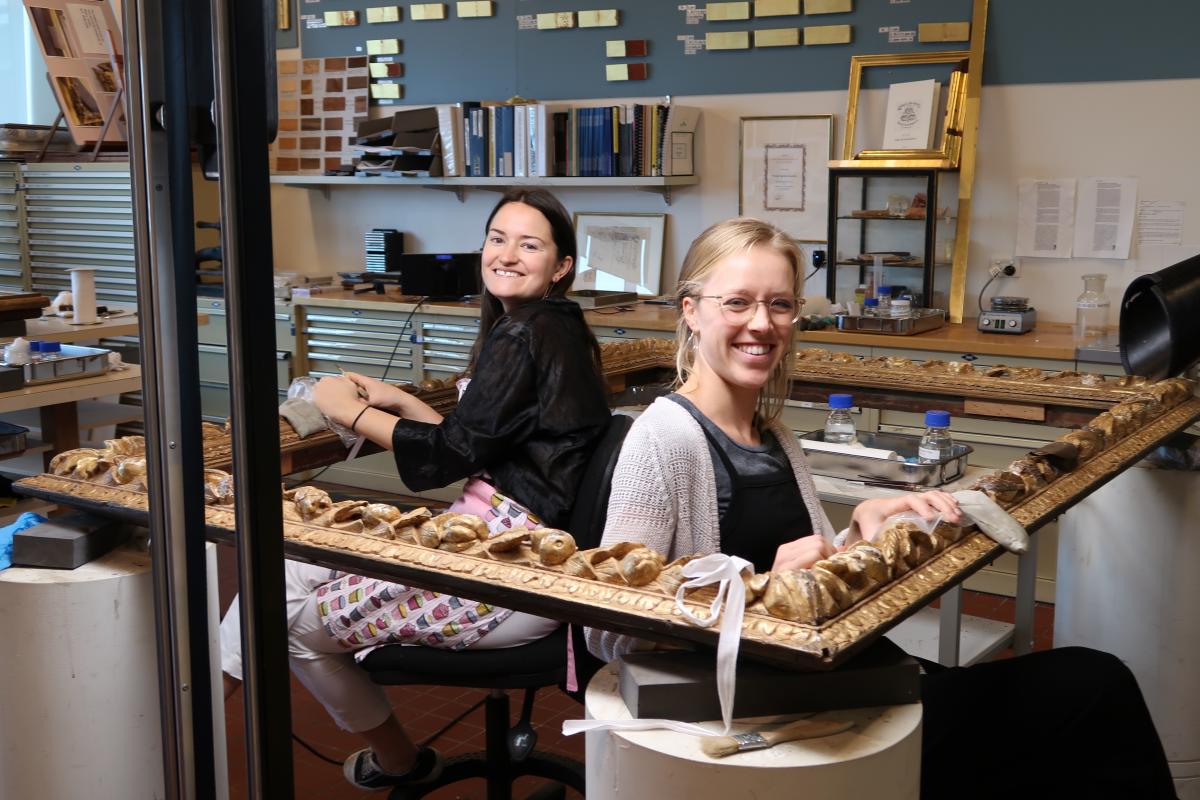
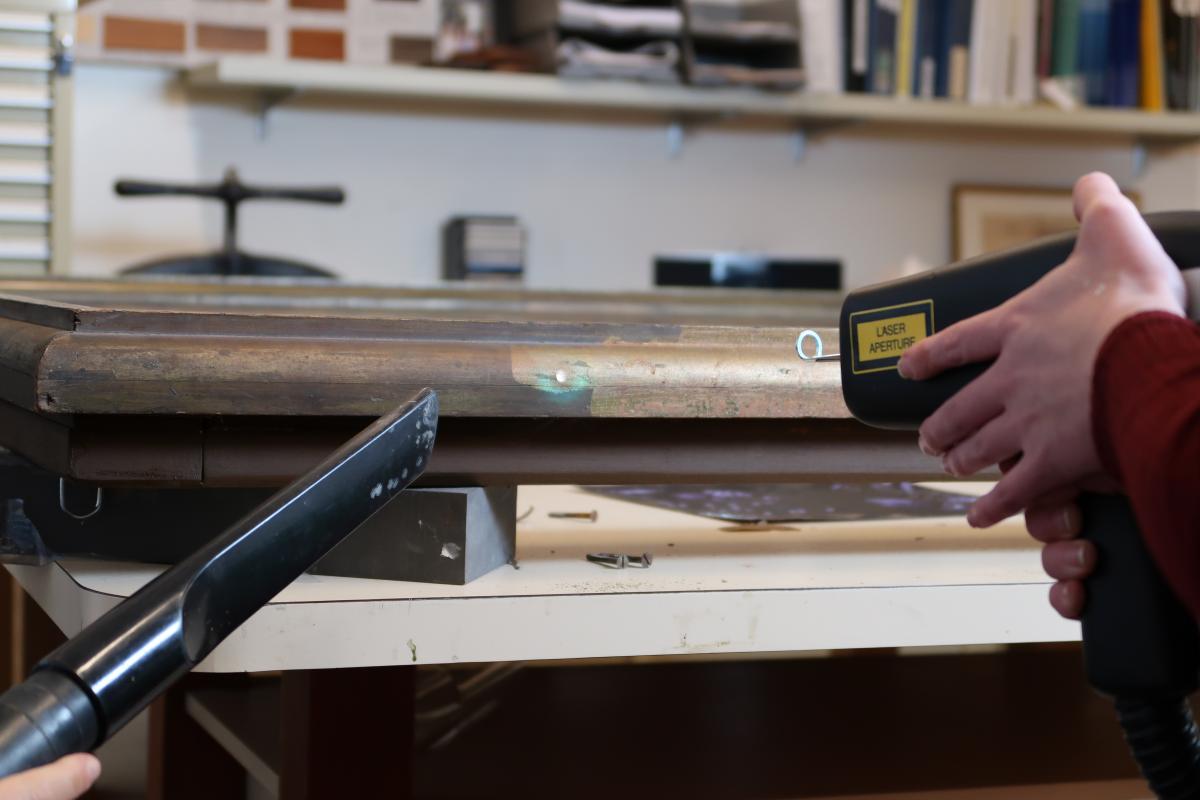
Paintings
The paintings section has been fortunate with the addition of intern Marjolein Hupkes from the University of Amsterdam who was able to complete a beautiful clean of Passing showers in preparation for the Arthur Streeton exhibition later next year (see her blog at https://www.artgallery.nsw.gov.au/blog/posts/beneath-a-passing-shower/). Other treatments in progress include Paula Dredge’s striking removal of a very dark varnish from Giovanni Domenico Tiepolo’s The apotheosis of a pope and martyr, Simon Ives has begun the extensive retouching phase of the now-cleaned Carlo Cignani painting The five senses, and Celine DeCourlon has completed her extensive treatment of the newly acquired Michael Johnson work Anna, returning the large-scaled early ‘hard edge’ work to its original grandeur.
Australian National Maritime Museum
Professional news
Treatment

The treatment and rehousing of 42 souvenir lifebuoys isn’t complete until you’ve blogged about it. The thrilling story of these objects is beautifully presented by Kate Pentecost (ANMM Digital Curator) in a blog entitled Oh buoy! at www.sea.museum/2019/07/03/oh-buoy.
Research
Katie Wood published her research and analysis of a 1602 Blaeu celestial globe on the museum’s website (https://www.sea.museum/2019/07/04/what-in-the-world).
Exhibition preparation
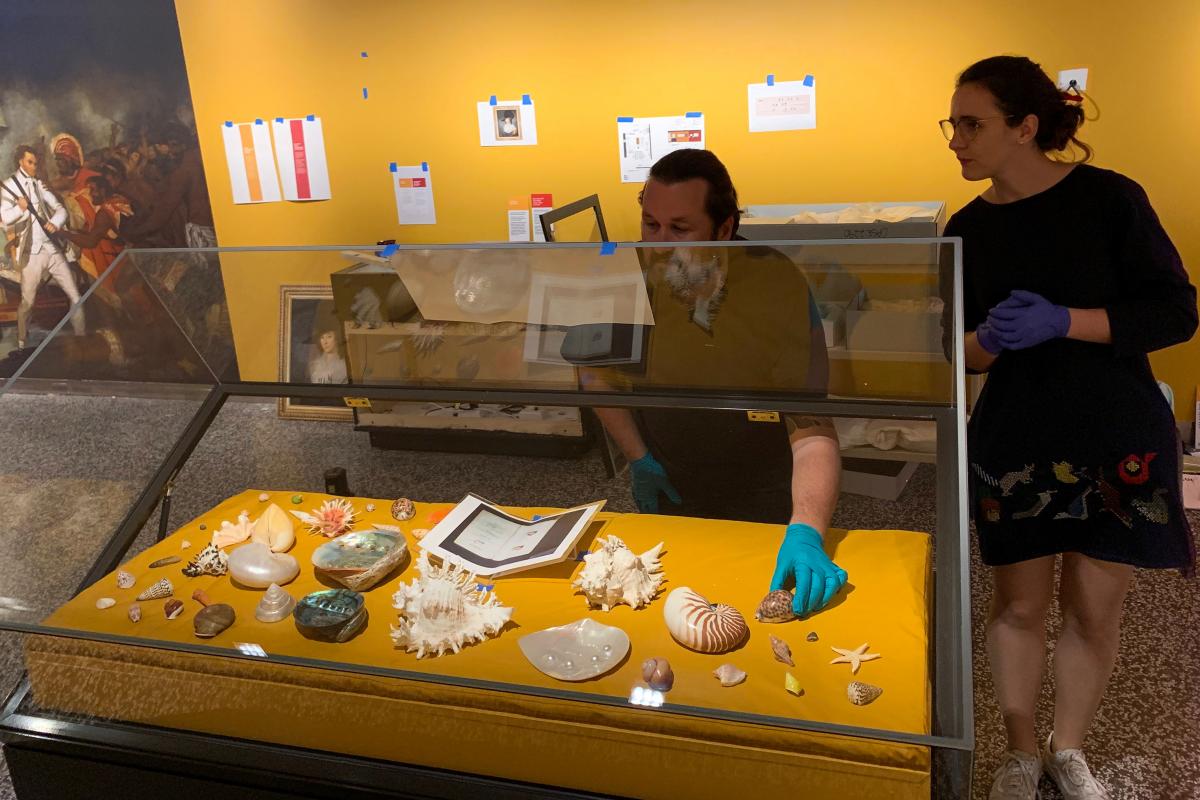
In July, Sue Frost, Jeff Fox, Lucilla Ronai, Katie Wood, Kevin Bray and Jan Russell (Conservation volunteer) installed the exhibition Bligh—Hero or Villain? This exhibition lets visitors cast a vote about what they think of William Bligh and his exploits. The exhibition includes loans from Silentworld Foundation, SLNSW, NLA, NPG and Royal Botanic Gardens, Kew. Special thanks go to Jan for making covers for several display cases.
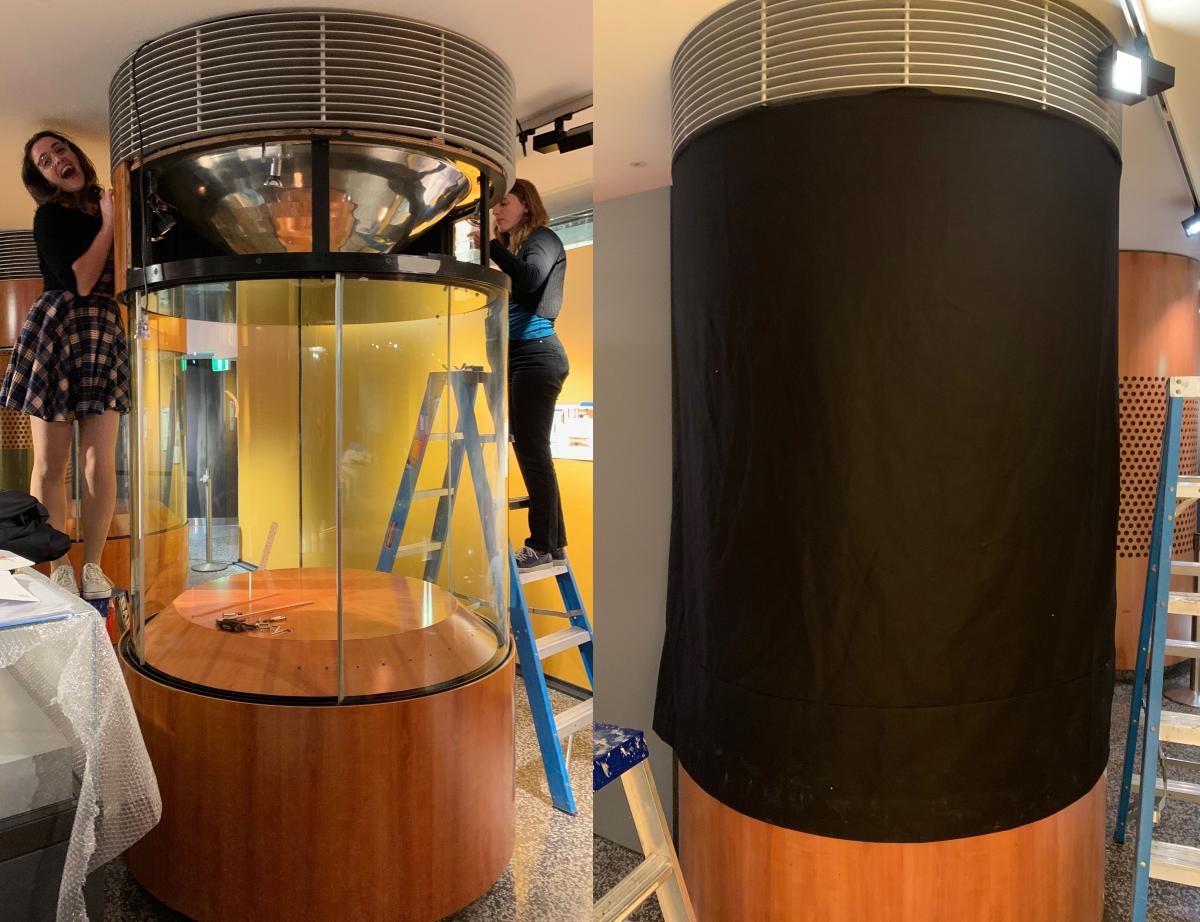
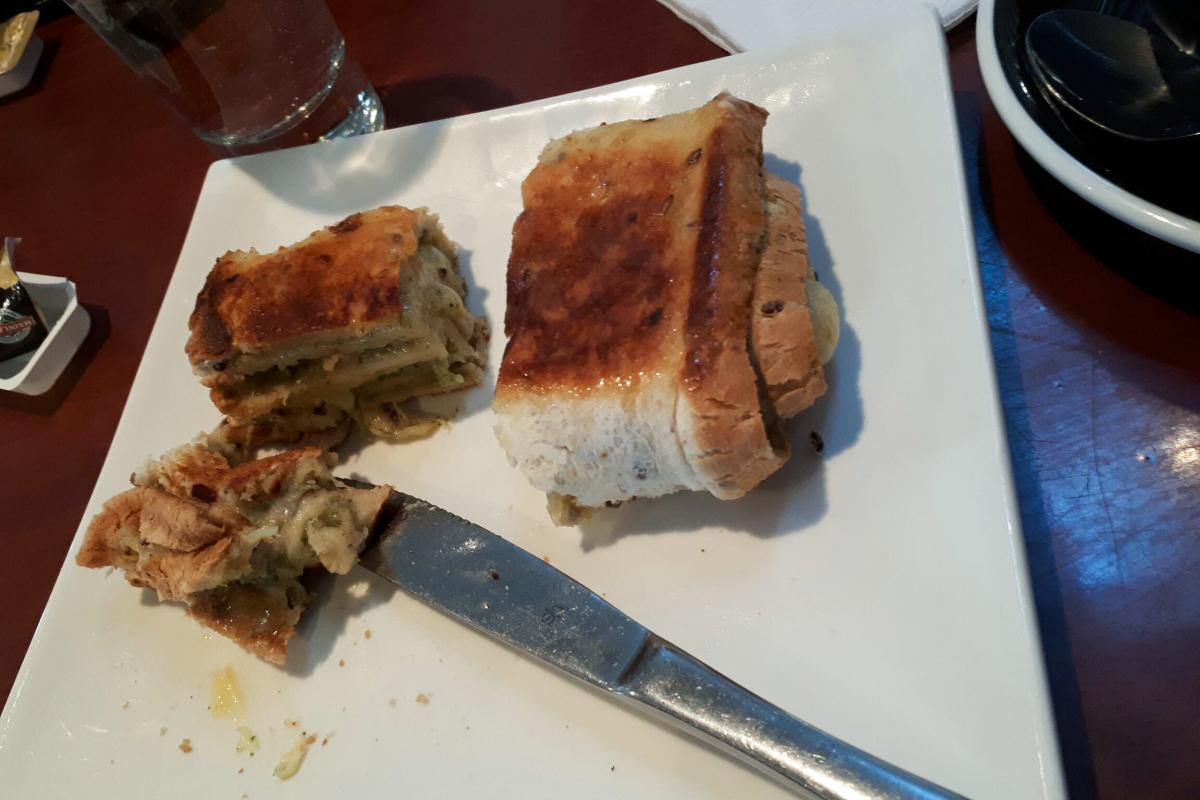
The museum’s James Cameron—Challenging the Deep exhibition has travelled to Otago Museum in Dunedin, New Zealand. Agata Rostek-Robak crossed the ditch for the installation and kept herself fuelled during a busy schedule with Dunedin’s famous cheese rolls. Agata brought back other stories of edible Kiwiana, including their beloved ‘lolly cake’.
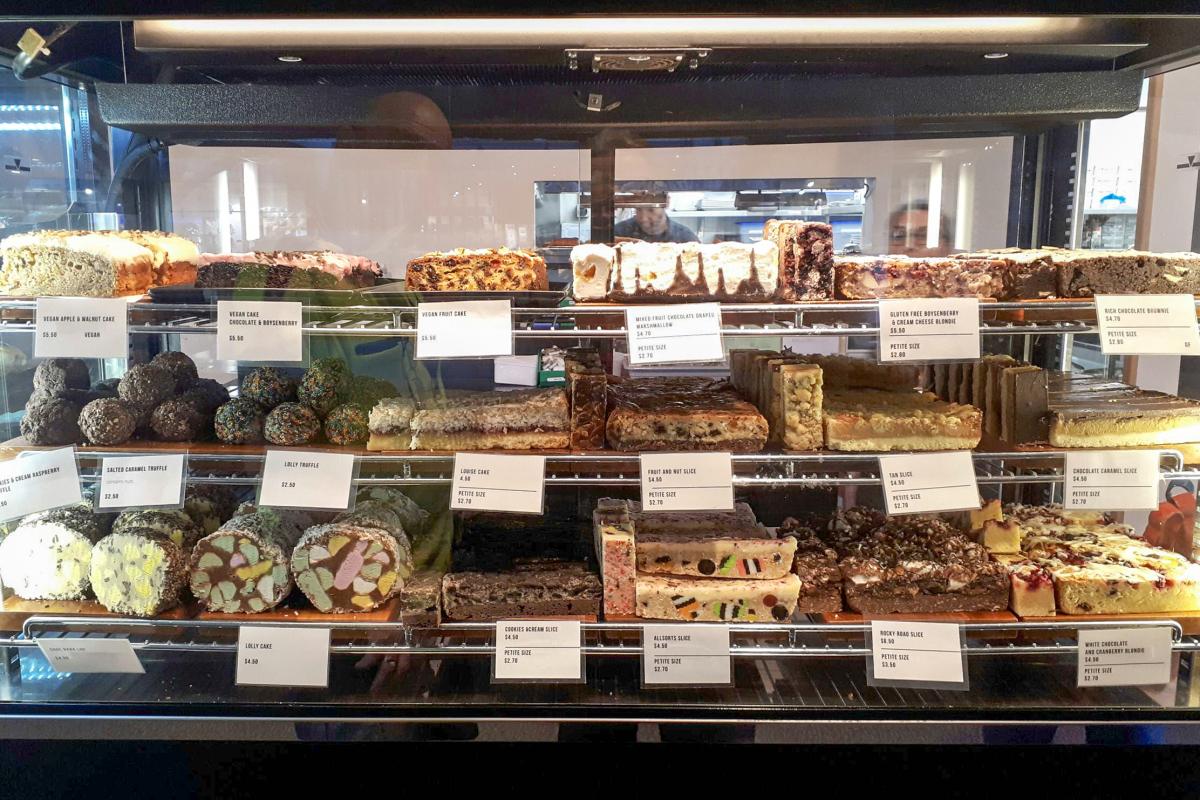
Workshops, symposia and media
In July, ANMM hosted the AICCM NSW Division event Opportunities Abroad. Lucilla Ronai and Nick Flood both presented, and video recordings from the event will soon be available online, so stay tuned.
Social news
On 4 July, we gathered cakes, biscuits and most of the museum to farewell Sue Frost on her retirement. Sue has spent over 23 years at the museum, a capstone to a fascinating career.
Sue was among the early intake of students of the conservation course at the Canberra College of Advanced Education (now University of Canberra). On graduating, she returned to Sydney and began working at the Museum of Applied Arts and Sciences (MAAS). There was no conservation department at that stage but, under the leadership of David Hill and Pat Townley, it was established and the Powerhouse Museum began to be built.
Early on, Sue had a short-term contract at the Australian Museum, where she worked under Sue Walston on the Balinese Paintings collection. She then spent time overseas in the textile conservation department at the Victoria and Albert Museum in London, under the direction of Sheila Landi. While overseas, Sue spent several seasons conserving ceramics with the Australian Archaeological Institute at the Torone site in Chalcidice, Greece.

On her return from Europe, Sue worked at MAAS, leaving prior to the opening of the Powerhouse to join Campbell Conservation (now ICS). There the pioneering team installed and travelled large international bicentennial exhibitions and established the private conservation facility that still stands in Chatswood, NSW. After ICS, she was self-employed for a number of years, often working in regional NSW.
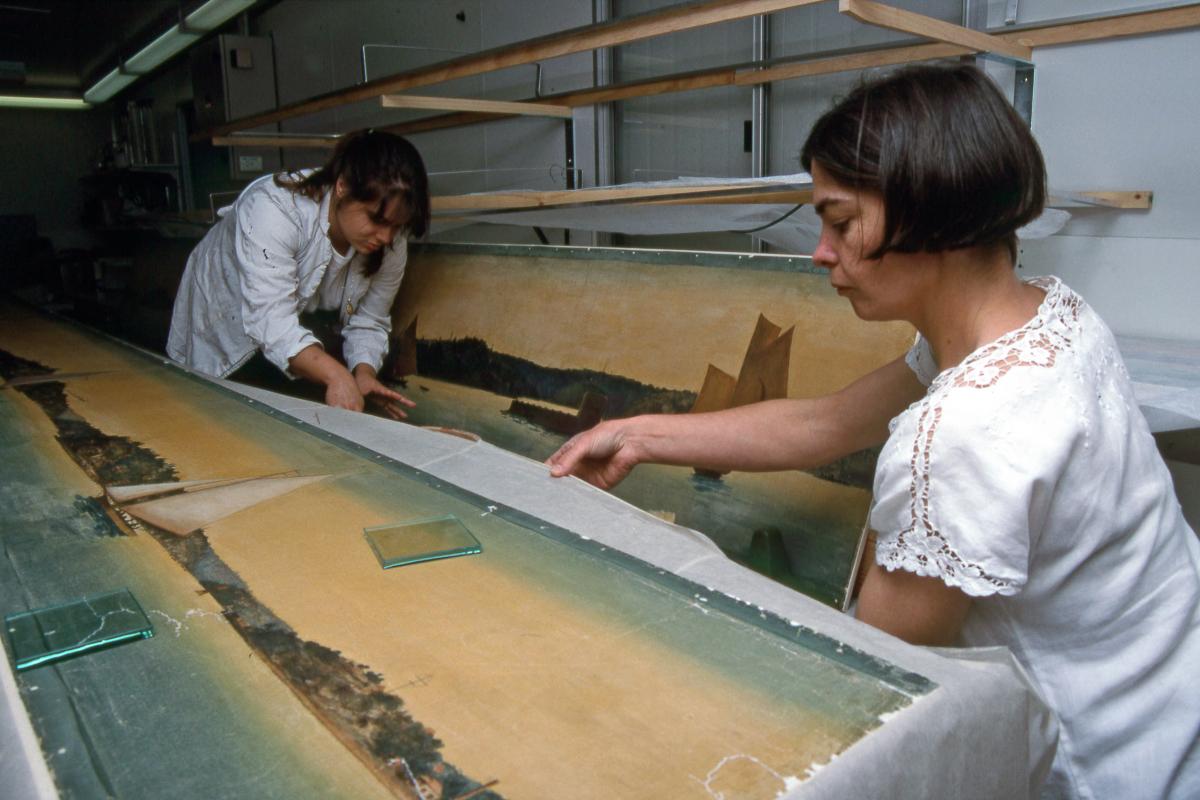
Sue joined ANMM in 1996 and worked first as Senior Textiles Conservator and then Senior Conservator—Exhibitions. During service that spanned more than two decades, she had many highlights and great experiences. Sue recounted to us:
I especially love the stories. Being able to get up close to and really experience objects related to stories from history I learnt as a child or have read about over the years, is still a real thrill. To have the opportunity to turn the pages of a special book … to see an object related to a significant person or event … and make your own assessment of its meaning or relevance is such a privilege.
We wish Sue well with the next phase of life and hope she visits the museum again and again. She knows that she’ll always be welcome here.
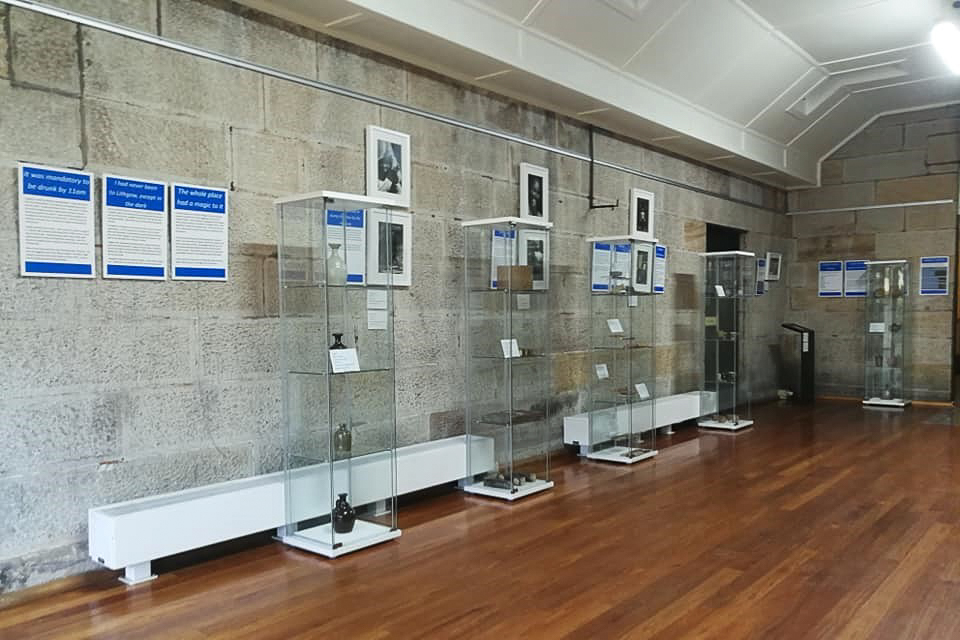
Rebecca Dallwitz is back at the Museum after a year at the Eskbank House Museum in Lithgow. A highlight from her time there was the exhibition No Turning Back. Rebecca designed the exhibition, wrote the text, purchased the showcases, selected the works with the artist Bob Cunningham and organised the opening and public programs.
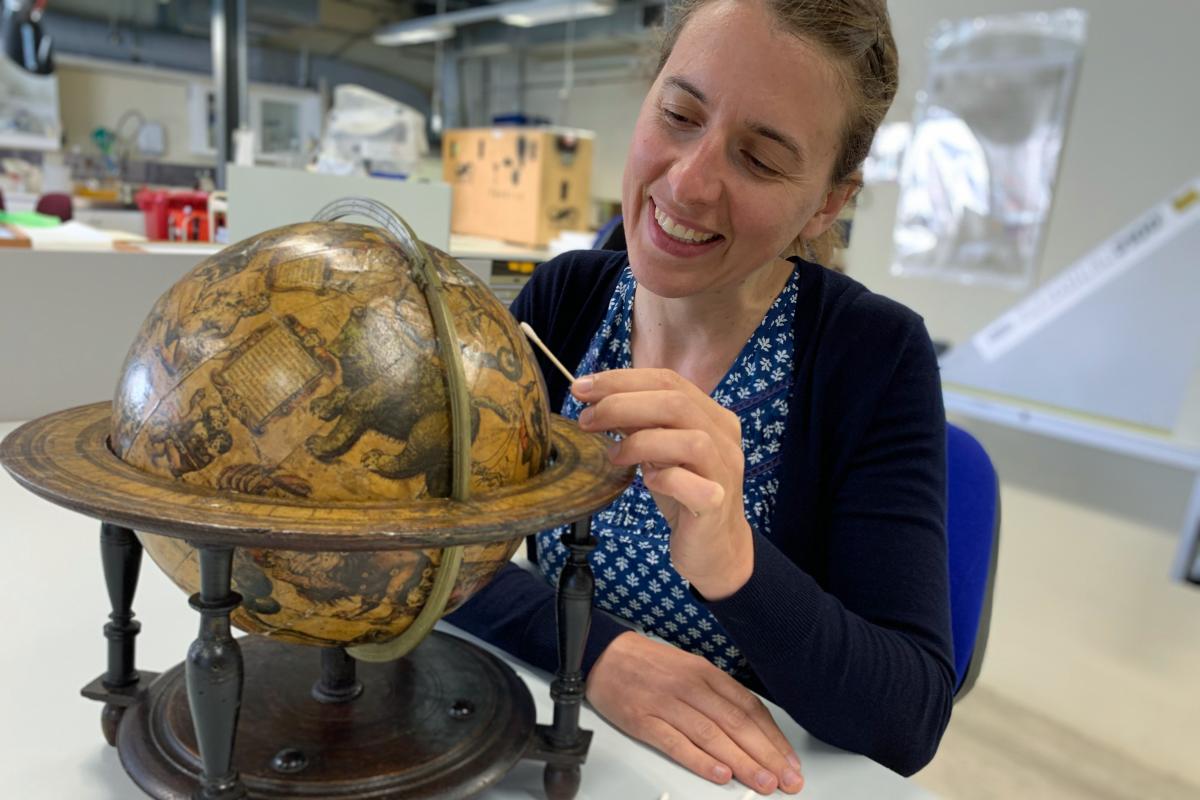
In July, Katie Wood returned to ICS after ten months at the museum. Katie has been an invaluable member of the team, and we thank her for her contribution and friendship.
Australian Museum
Professional news
Long-serving Manager of Conservation, Colin Macgregor, is now enjoying his well-earned long service leave prior to retirement. The period of sequential acting management has commenced with the role to be shared between Sheldon Teare (Natural Sciences Conservator) and Heather Bleechmore (Objects Conservator). Sheldon has been acting since May 2019 and will be in the role until February 2020. Heather will act from February 2020 until October 2020.
Project Discover
Big news! Next week, on 19 August, the Australian Museum will close its doors to the public for one year. This is to allow a major redevelopment of the Museum site to be carried out. Entitled Project Discover, this major building work will see the heart of the Museum transformed into gigantic exhibition halls, allowing for much larger exhibitions than have been possible previously. This means that much of the material in existing collection storage areas and galleries is being packed up and relocated to off-site stores. Project Discover will bring many positive changes to the Museum. Despite the fact that there will be no patrons in the building, the back-of-house work of CC&C continues unabated and it will be full-steam-ahead for all of us as we ensure collection items are, where possible, either out of harm’s way or have had risks mitigated during the building works.
A name change
The Materials Conservation Department has changed its name. It is now ‘Collection Care and Conservation’or ‘CC&C’, for short. This shift in title better represents the work we do across all the Museum’s collections and galleries, which is so much more than just caring for physical materials. The name change also better reflects our role within the organisation—which we hope is better understood.
Staff
We happily welcome several new staff members into the CC&C team. Robert Clendon joins us from Museum of New Zealand Te Papa Tongarewa and will be backfilling Sheldon Teare and Heather Bleechmore during their periods of acting in the manager role. Clare Kim is with us for three months to look after the environmental monitoring program. Melissa Holt will be backfilling Megan’s Fridays until the end of the year.
Exhibitions
Michael Kelly is preparing a number of objects from the International Collection for an exhibition entitled China—Splendid Traditions to be displayed in the Panizzi Gallery, University of Wollongong.
Loans
Michael Kelly has also carried out the conservation work for a loan of objects from the First Nations Collection to be part of the Art Gallery of South Australia’s exhibition Bunha-bunhanga: Aboriginal agriculture in the south-east.
Projects
As part of a team, Megan Dean-Jones and Sheldon Teare spent a chilly week in June installing the new Chapman Collection exhibition in the Australian Fossil and Mineral Museum in Bathurst. The collection will stay in Bathurst for a few years during the AM’s extensive building works. It has received a lot of local media attention, looks absolutely fabulous in the new space and has been drawing great crowds! Go and check it out.
The Pacific Collection Relocation Project is almost complete and marks the beginning of several stages of Project Discover. After leading the conservation team involved in the relocation, Heather Bleechmore is focusing on preventive program aspects of the building works such as vibrational impact assessments and environmental monitoring.
Fiona Hurel, Kyra Kim and Graham Parker have been working through the Search and Discover Relocation Project creating bespoke stillages for a large collection of historic skeletons and hundreds of other Natural Science specimens. The bulk of these specimens will be transported to our Castle Hill off-site store next week.
Heights Heritage Conservation
Professional news
Treatment Projects and Exhibitions
June saw Tess Evans reinstalling Not Just Stitches in Penrith Library. It consists of seven beautiful handmade quilts designed by Maine Morris depicting women in the Penrith area over the last 200 years. Once cleaned and remounted, they were showcased in acrylic boxes and hung on the walls of the library. The finished product looks spectacular, a beautiful celebration of both the history of the quilts and the local women they depict.
Tess continues to tackle the mammoth task of cleaning and rehanging the stunning Mona Hessing Banner tapestry for the University of New South Wales. The giant is 24 metres of beautifully hand-woven tapestry panels, which promises to keep Tess busy until they are returned home to be hung at the University … Watch this space!
This quarter has had rather an ongoing cricket theme with lots of memorabilia coming in from the Bradman Museum in Bowral and private collectors alike, including a sentimental family heirloom that had been taken to with a permanent marker by a cheeky grandson… Howzat!!!
Artist Stephen Birch’s Accumulations/Accretions belonging to Wollongong Art Gallery is all set for restoration, having made a rather ungracious journey to North Curl Curl. The striking sculpture consists of a giant spider with a human face and a full-sized Spiderman mannequin. Birch liked to play on popular culture, confronting viewers with contradictions of super powers versus real life. Sadly, Birch passed away in 2007. May his message live on through his art.
Recently, the studio had a rather prestigious visit from the uniform of General JJ Paine circa 1890–1900, which usually resides at the Hawkesbury Regional Museum. Tess lovingly restored the uniform from button-hole to belt buckle, the result of which was a very smart-looking mannequin indeed.
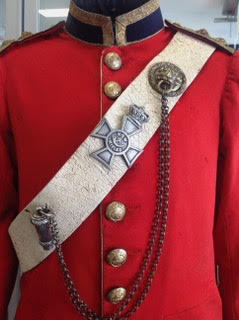
Also, a big welcome to Lauren Goldsack, who has joined the Heights Heritage team as executive assistant.
Social news
Sadly, Tess’s mother passed away in May this year, aged 93, after sustaining several falls and progressive dementia. Kennema (AKA Kay) worked for a number of years in the library of the Textile Conservation Centre at Hampton Court Palace, in the early days of cataloguing and sorting. I believe her unique coloured spot system lives on …
Keeping it in the family, on 18 June Tess’s parents-in-law celebrated 70 years of marriage. Only one per cent of the population reaches this milestone event, which was acknowledged by Queen Elizabeth in a beautiful card.
This month has also seen Tess create three 1920s costumes for three very different characters for the play Speak … Easy as part of the Sydney Fringe Festival, in which her sister, Jane Bergeron, is performing.
Link to tickets: https://sydneyfringe.com/buy-tickets?e=MTg1MDU
International Conservation Services
White Rabbit Gallery—the partnership
White Rabbit Gallery is preparing for their next amazing exhibition and ICS is assisting with the diverse problems associated with contemporary art. The array of complex materials and often large scale of the artwork has required the utilisation of the skills and experience of the paper, textiles, paintings and objects conservation teams.
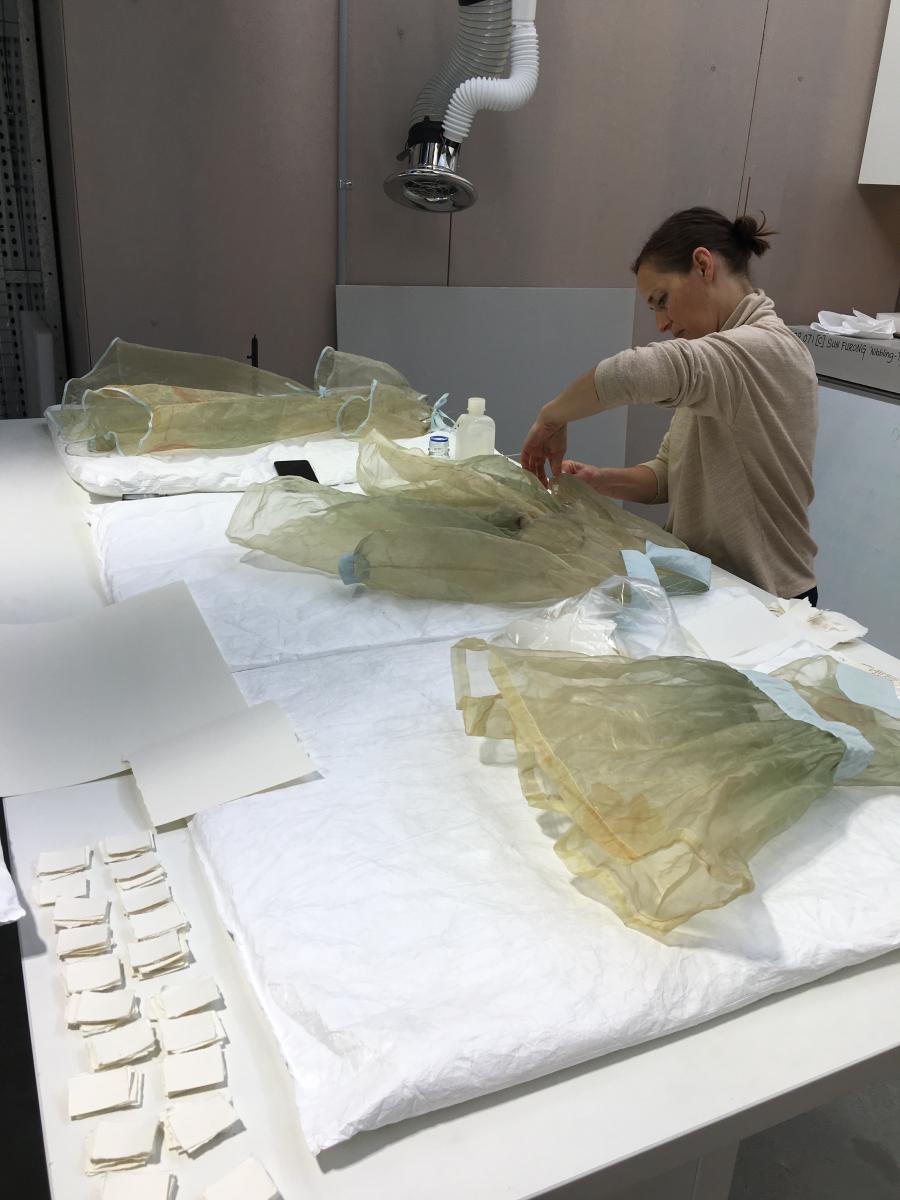
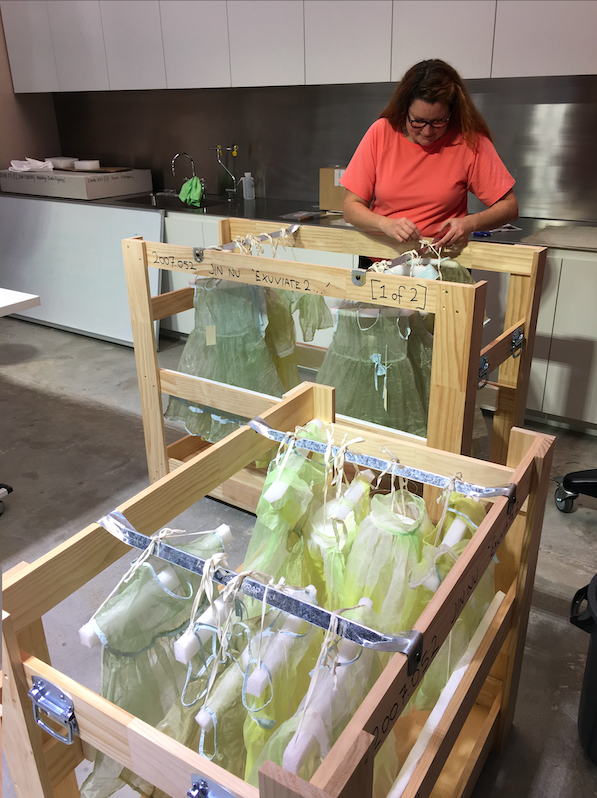
Fremantle Prison murals
Adam Godijn, Head of Conservation—Fine and Decorative Arts and Matteo Volonté, Senior Paintings Conservator, conducted an extensive survey on the various prison murals. This prison was built by convicts and remained in use until 1991. ICS surveyed over 50 indoor sites, cells and outdoor murals to determine the best plan for the continual preservation of the art in this world heritage site.
Herbarium—Royal Botanic Gardens
ICS has been contracted to work with Picturae, a Netherlands-based company that is undertaking the digitisation of approximately 1.4 million herbarium samples at the Royal Botanic Gardens in Sydney. Picturae has developed some smart hardware and software, which uses conveyor belt technology to safely handle and accurately digitise vast numbers of specimens at speed. ICS currently has five staff working on site for the first part of this 20-month project (reducing to four staff after the most complex component of the collection has been digitised).

Metro
The current trend for Australia’s major cities to build metro lines, whether they be in Brisbane, Sydney or Melbourne, may not seem to have a direct impact upon the world of conservation. However, last year the Metro project in Sydney resulted in ICS excavating and removing possibly the earliest extant Australian boat from the Barangaroo station site. Alongside this, and only recently completed in August 2019, is excavation on the Metro in Melbourne, where we have been working with archaeologists at the Latrobe Street site. Lauren Keating initially led our team on site, and in the latter part of the project Kristine Allinson (having worked alongside Lauren) has stepped into that role. Follow-up analysis and treatment of a selection of artefacts from the Latrobe Street site will now be undertaken in the coming months.
Technical Assistance—Sydney Analytical, University of Sydney
In May we had two technicians from Sydney Analytical come to ICS to conduct tests on a suspicious painting. Paintings conservator Julia Mauny-van den Burg suspected that a painting that came in for treatment may have contained arsenic. Technician Elizabeth Carter and Therese Carter came in with specialist equipment, the XRF Bucker 5i Tracer, to take readings from selected areas of the painting. Elizabeth and Therese Carter went back to their lab to analyse the data taken in order to determine if arsenic was present. Thankfully after a week of waiting, the results came back and the painting was arsenic free!
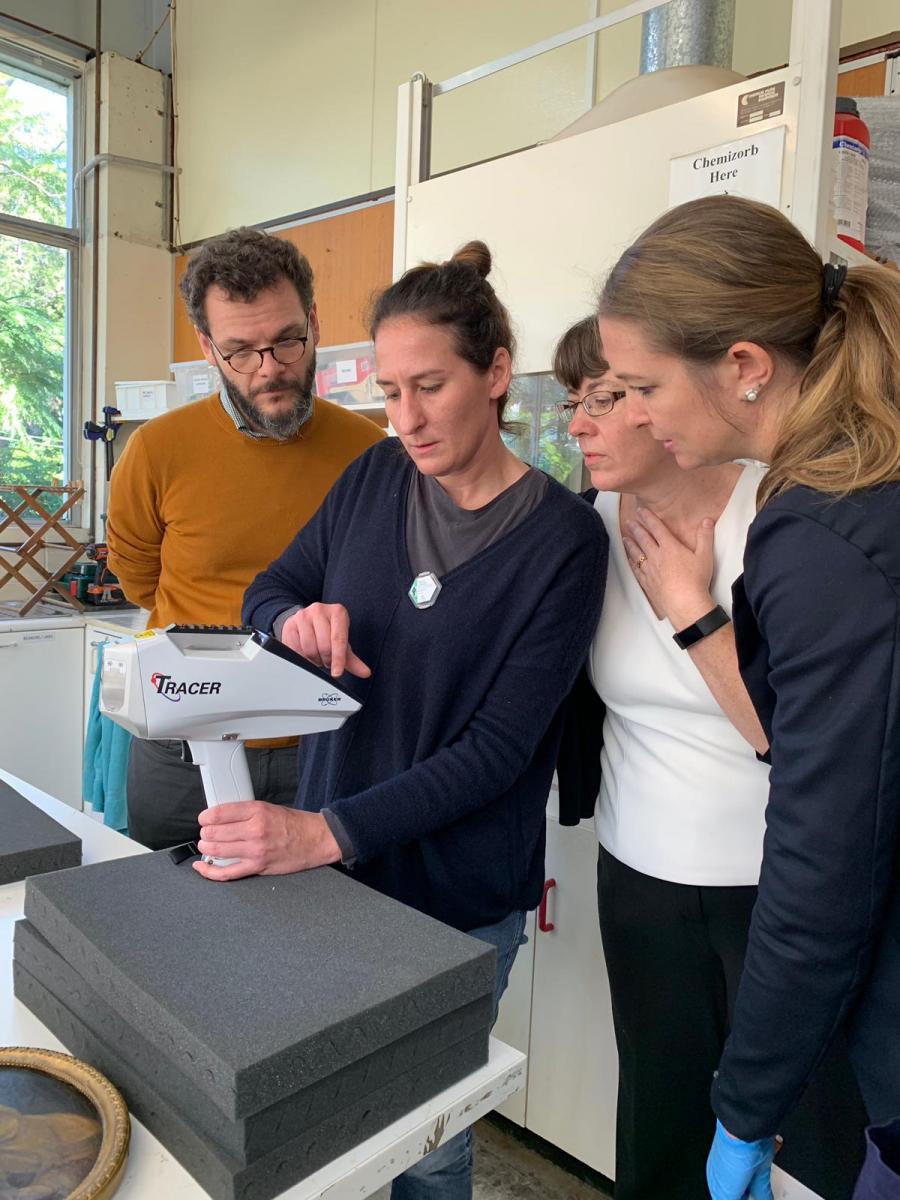
Staff members
Congratulations to Wendi Powell, who recently was promoted to Senior Paper Conservator in recognition of her ongoing and solid contribution to ICS. Well done Wendi!
James Kleppen, Conservation Projects Manager in the Outdoor Heritage and Objects team, has sadly left ICS to take his career in a new direction. James has taken a position at Parliament House within the Capital Works Team as a Project Officer. We wish James success in his new endeavours.
The Bizops team has undergone a re-structure in order to provide the teams with better support as our company expands. Katherine Figueiredo has been promoted to Administration and Projects Officer for the Fine and Decorative Arts Department. We also welcome a new addition to the team, Grace Bushrod, who will take on the role of Administration and Projects Officer for the Outdoor Heritage and Objects Department. Grace came to us from Art Index and will share with us her extensive knowledge, managing a wide range of administration and project support. Welcome Grace!
Astra Delaguiado, our Finance Officer, has left ICS in pursuit of an amazing career working for KPMG as National Finance Manager. Astra will be sorely missed! Patricia Wong, our Finance Assistant, has stepped up to the role of Finance Officer and we welcome another new addition, Catherina Lee, who is our new Finance Assistant.
Museum of Applied Arts and Sciences Powerhouse Museum
We welcome Chris Redman as a conservator, who is backfilling Rebecca Ellis’s position, and assistant conservators Ruth Drayson and Irene Finkelde, who have recently joined the assessment team for the Collection Relocation Logistics Project.
Exhibitions-related tasks have included installation of the Apollo 11 exhibition, which celebrated the 50th anniversary of the first spaceflight to land astronauts on the moon, and dismantling of the Akira Isogawa exhibition.
Suzanne Chee is preparing selected costumes for Jenny Kee and Linda Jackson: Step Into Paradise, an immersive exhibition, which will be the first in-depth survey to capture the dynamic energy of this creative partnership.
Gosia Dudek is co-ordinating the conservation of items selected for the Linear exhibition, which explores, through the unique, diverse and personal voices of a remarkable group of Australia’s First Nations peoples, the concept and significance of line and lineage within Indigenous cultural narratives and practices, across science, technology, design and aesthetics. Several objects chosen for this exhibition have been selected for scientific analysis—a boomerang for radiocarbon dating, and several grinding stones and mills for starch analysis and identification.
Skye Mitchell has started the intensive course on ‘Managing Collection Environments: Preserving Collections in the Age of Sustainability’ run by the Getty Conservation Institute.
Kate Chidlow continues the IPM program roll out across the three MAAS sites. The data will be collated and used for research on the EMu Trap tab. Work continues on the Rolled Textile Project, where we are currently three-quarters of the way through photo-documenting and re-rolling the 1700 textiles that make up the collection.
Sue Gatenby has written nine Hazardous Materials Fact Sheets as part of the Collection Relocation Project and will be presenting these Fact Sheets to staff.
As part of a community engagement between the Sydney String Centre, a violin maker and St Vincent’s Hospital, the MAAS has been approached to facilitate the CT scanning of several stringed instruments in our collection—violins, voila and a cello. This scanning will provide information about arch depths, corner blocks, ribs and linings, grain of timber and repair marks.
The conservation lab will be undergoing some changes and movements to make room for the increasing number of staff required for our Relocation Project.
Preservation Australia
It seems all good things must come to an end—and so it was when Tegan Anthes decided it was time for a change and left us at the end of June. After 11 years, the studio is a different place without her, but we are managing—and inviting lots of people over for morning tea (including Tegan).
Beate Yule oversaw a large project for Sydney City Council archives, which included digitising a very large map following conservation and flattening. To this end, the digitisers came to us—ladders and all (see photo). Beate is now working through conserving and re-housing a Sydney artist’s life work, which is taking up most of her time.

Kay Söderlund is having a lovely time with a lot of hands-on treatment, preparing for our second semester workshop week in September—and trying to stay on top of IT issues now that Tegan has gone. She recently completed quite a challenging treatment on a large Charles Blackman acrylic on paper that had fallen off the wall—many large tears and losses (cleaners threw out some pieces) and VERY brittle paper.
We recently hosted the AICCM NSW branch evening of ‘Tips, Tricks and Tools’, reported on separately in this newsletter—lots of fun and some great suggestions.
We have also cleared out some space downstairs in order to sub-let as we really have more space than we need. It suits photographers, jewellers, artists—or even a conservator or two! Please contact us if you are interested.

Following on from our membership email regarding Preservation Australia being an open studio until mid to late 2020, we have had several conservators take us up on the offer. But there is plenty of space and time available so please contact us if you are interested. We are planning to run a series of casual professional development workshops over the next year – using the expertise of AICCM members around Australia. So if you would like to share your skills (on a paid basis), please contact us.
And, of course, I am still looking for the right person to take on and continue Preservation Australia and/or Conservation Resources …
State Library of NSW
Social news
The Collection Care Branch would like to welcome Meg Driver. Meg will be backfilling Lauren Dalla’s role as Assistant Registrar while Lauren is on parental leave. Kate Hughes has taken up the role of Senior Conservator of Books, Objects and Paintings while Felicity Corkill is taking maternity leave. Catherine Thomson, our Senior Conservator of Collection and Storage, is taking a well-earned holiday over August and September. During this time, book conservator Nikki Ellis is acting in Catherine’s role.
Professional news
Conservators Nichola Parshall, Cecilia Harvey, Wendy Richards, Steven Bell and Kate Hughes have completed the washing, deacidification and resizing of over half the pages of A Journal of the proceedings of His Majesty’s Bark Endeavour on a voyage round the world, by Lieutenant James Cook. This treatment is addressing the deterioration of the iron gall ink media in preparation for exhibition in 2020.
Steven Bell, Guy Caron, Nicole Ellis, Felicity Corkill and Kate Hughes have commenced a survey of the Library’s significant Rare Books Collection. The survey is capturing the current condition of the books along with their future treatment and storage needs.
The Collection Care DEP team has started preparation of the architectural dyeline plans for digitisation. This is a collection of nearly 1300 diazotype architectural plans including plans of the Sydney Opera House and Luna Park. The team have also started investigating treatment and rehousing options for the gramophone record collection which will be digitised in-house.
Exhibitions
The Exhibition and Loans team, along with Assistant Conservators team, have been busy preparing and installing collection material for Living Languages: Country, Culture, Community. As part of the UNESCO International Year of Indigenous Language, this show celebrates the resilience of Aboriginal languages using original documents and interviews with language custodians in New South Wales. The exhibition will be open until Sunday 17 November 2019.
The teams have also been occupied with preparing material for loans to other institutions. Several collection items have been loaned to Museum of Sydney (Sydney Living Museums) for the exhibition Songs of Home, and to the Australian National Maritime Museum’s Bligh—Hero or Villain. The Library has also loaned items from the poster art and public protest poster collection to the National Art School Gallery for their show Paper Tigers: Posters from Sydney’s Long ’70s.
Workshops and training
Kate Hughes will undertake the ‘International Course on Conservation of Japanese Paper’ in Tokyo this September. In this intensive course, Kate will gain in-depth, holistic knowledge and experience in traditional conservation techniques dealing with Japanese paper through a mixture of lectures, practical workshops and study tours to traditional papermaking masters and mounting studios.
Helen Casey commenced ‘Preserving Collections in the Age of Sustainability’ course, run by the Getty Conservation Institute. This three-stage course includes a ten-week online training program, to be followed up with an intensive two-week workshop in October held at NGV, and long-distance mentoring program for six weeks, to begin in November. In this course, Helen will be exposed to current knowledge, research and practice in the fields of material/environment behaviour, risk management and sustainable collection care.
Natalie Rose Cassaniti, Assistant Conservator, Digital Excellence Program, has recently attended the ‘Biennial Audio-Visual Archival Summer School (BAVASS) 2019’ held at Indiana University, Bloomington, USA. The program was initiated by the director of the Indiana University Libraries Moving Image Archive (IULMIA), Rachael Stoeltje, and FIAF’s Training and Outreach Coordinator, David Walsh, with a view to training a new generation of audio-visual (AV) archivists and to foster a collaborative network of professionals.
The comprehensive program covered the whole spectrum of film, audio and video preservation. Core topics included handling, storage, disaster preparedness/management, digitisation and digital storage/preservation, cataloguing, copyright, programming, project management and community engagement. Lectures and hands-on workshops were held six days a week for a fortnight and led by a group of trainers from IU and international experts. The program also featured film screenings of restored movies and site visits to libraries and archives within the IU campus, including the phenomenal Ruth Lilly Auxiliary Library Facility, home to the moving image collection.
Monthly collaborative meetings conducted online with the BAVASS team will follow the program to ensure education and networking is maintained. Natalie was one of 50 candidates to be selected from around the world.
Sydney University Museums
Research projects
In August, we had Melbourne University conservation student Melissa Holt undertaking research work on the pillars of the tomb chapel of Mose. She’s looking at an unknown coating that has now discoloured and is associated with soiling and oily looking deposits. A significant part of the project is working with Sydney Analytical using Raman spectroscopy and FTIR to characterise the coating. This work will form the basis for Melissa’s Masters project and also enable us to return these objects to a displayable condition.

In the lab
We’ve just received our newest piece of kit—a large washing sink. There was much concern when we saw the ginormous crate it came in, but with the help of four burly tradies and some dollies, it made it into the lab (just!). We had to take apart the suction table and store it inside the sink to make some room. As is the case, the important thing is to find the appropriate name for it. The current front runner is ‘Titanic’.

Northern Territory
Museum and Art Gallery of the NT
Staff changes
MAGNT Collections Care have been fortunate to provide a secondment to one of our VEO’s (Volunteer Engagement Officer’s) into a temporary Assistant Collections Technical Officer role, and welcome Bijmoon Tamanna, whose aptitude for and assistance with condition reporting and exhibition installation have been much appreciated during this busy period.

Events
In May, MAGNT collaborated with DesArt in hosting five arts workers from different communities around Alice Springs, providing them with hands-on museum experience. Eliana Urrutia-Bernard demonstrated appropriate handing followed by a practical workshop in which the group assisted her in installing our exhibition Momentum. Lisa Nolan gave an introduction to basic conservation techniques focusing on IPM, and Sandra Yee had the group assist with the preparation of the Telstra National Aboriginal & Torres Strait Islander Art Awards (NATSIAA) material by learning how to hinge works on paper and stitch woven mats to wall supports.

Exhibitions
Conservators Eliana Urrutia-Bernard and Sandra Yee have had a busy several months preparing for our annual Telstra NATSIAA exhibition, now in its 36th year. Working together with NATSIAA exhibitions coordinator, Fiona Bennie, and assistant collections technical officers Bijmoon Tamanna and Paula Chappell, we had a significant improvement in exhibition delivery with a smooth-flowing lead-up to the opening. This year MAGNT had 68 finalists from all over Australia and, with such a large collection of works descending on us, the NATSIAA exhibition was spread out over two gallery spaces and used up every spare millimetre of space available in collections areas whilst preparatory work was being undertaken.
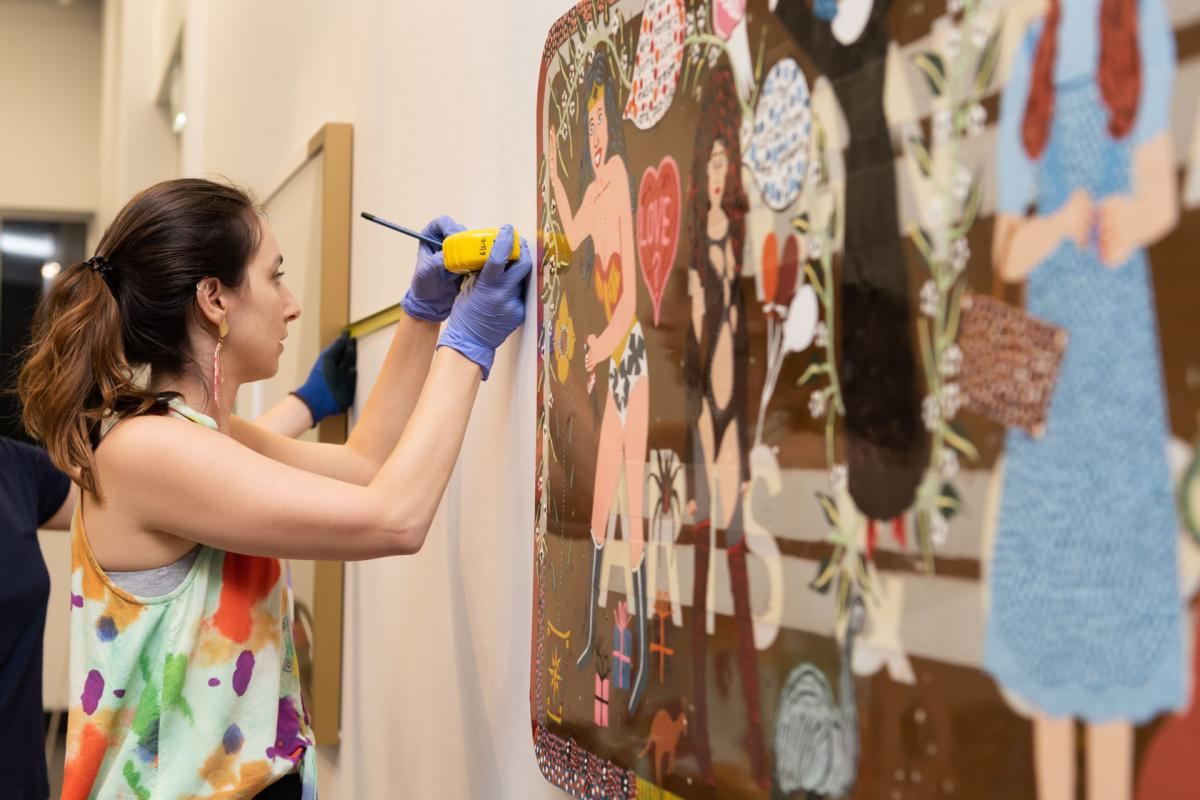
Following the brilliant success of NATSIAA, Conservation is now focusing on the upcoming exhibition Therese Ritchie: Burning Hearts, a retrospective show depicting highlights of the prolific territory-based artist’s work. With a collection of 89 printed media works to be displayed, Sandra and Eliana are looking at options for framing and float-mounting pieces in-house, in consultation with MAGNT Curator Wendy Garden.
Conference attendance
Sandra Yee will be attending the ICOM conference in Japan this September and we are looking forward to hearing her feedback.
Social news
Conservator Lisa Nolan is currently on long service leave and will be returning in January 2020.
Queensland
Cairns Historical Society
Cairns Historical Society owns and operates Cairns Museum, located in the original School of Arts building on the corner of Lake and Shields streets in the heart of Cairns CBD.
The society has an archive and object collection of 60,000 pieces relating to Far North Queensland history, as well as a 35,000-strong image collection.
We closely collaborate with our partners at James Cook University and our regional colleagues in the Torres Strait and Papua New Guinea. We’re all facing the same climatic conditions and threat of mould!
Our team of dedicated volunteers work across a variety of functions at the society, 20 of whom work with Melanie Sorenson in the collections area of the organisation. Melanie, formerly from the National Library of Australia, heads up a preservation training program for the volunteers as collection manager at the museum. Volunteers are trained in basic collections care, basic book cleaning, phase box-making and preparing material for digitisation through regular monthly training workshops and one-on-one or group projects, such as this one!
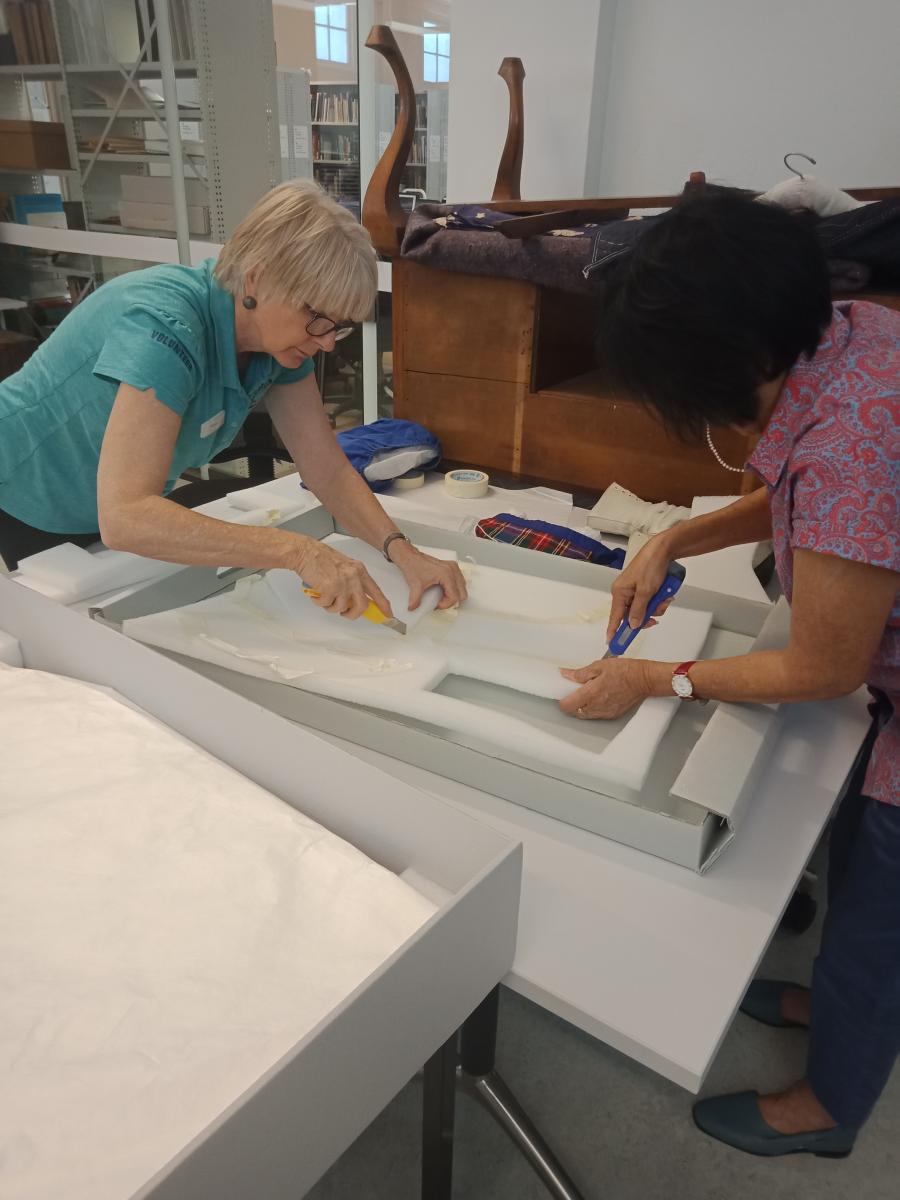
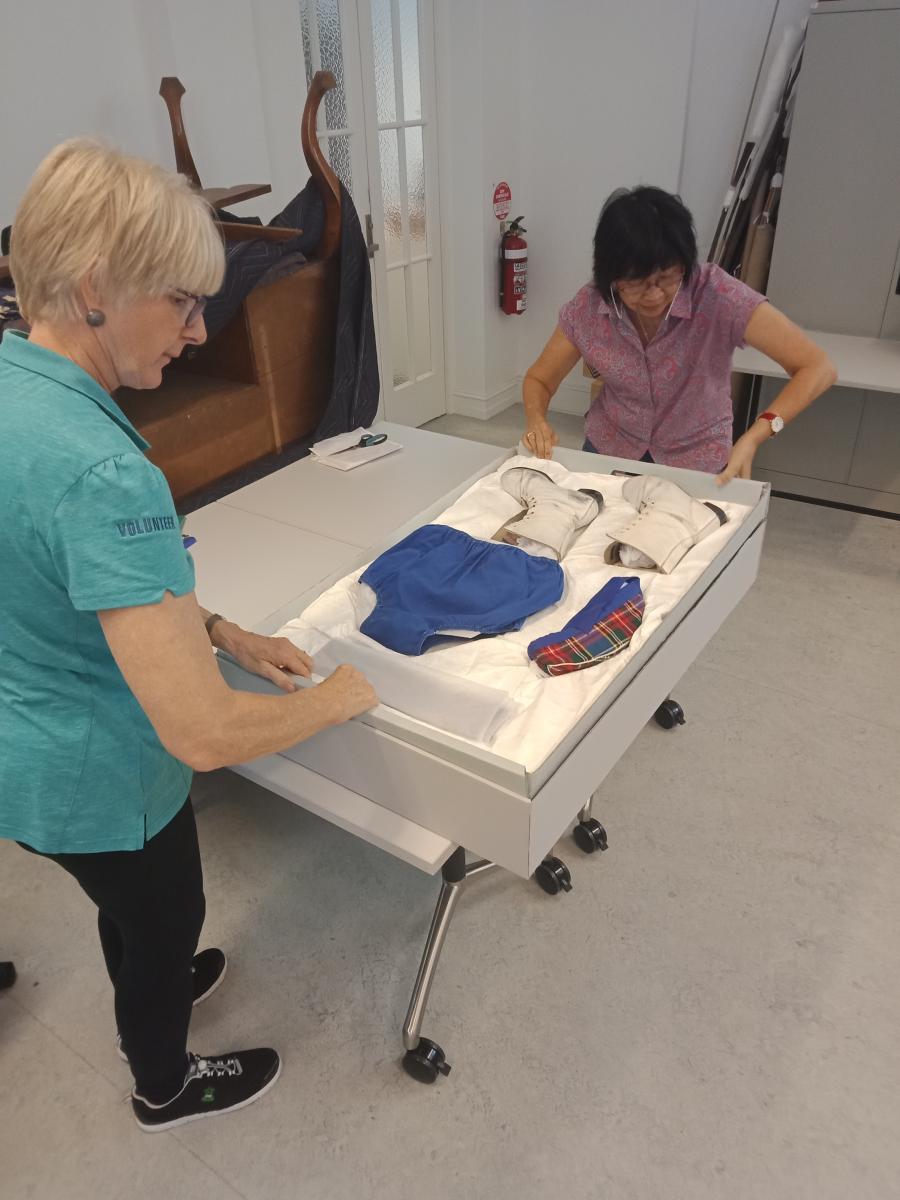
We had a great afternoon packaging a marching-band girl’s uniform, complete with boots, whistle and Conclarry tartan. The volunteers were trained in making an archival box and fit-out with Ethafoam for the uniform and all of its accessories.
We also celebrated book week for the adults by making phase boxes for our ledger collection—box making is our super power! Please check out the Cairns Historical Society Facebook page (https://www.facebook.com/CairnsHistoricalSociety) for a snap of our awesome box-making prowess.
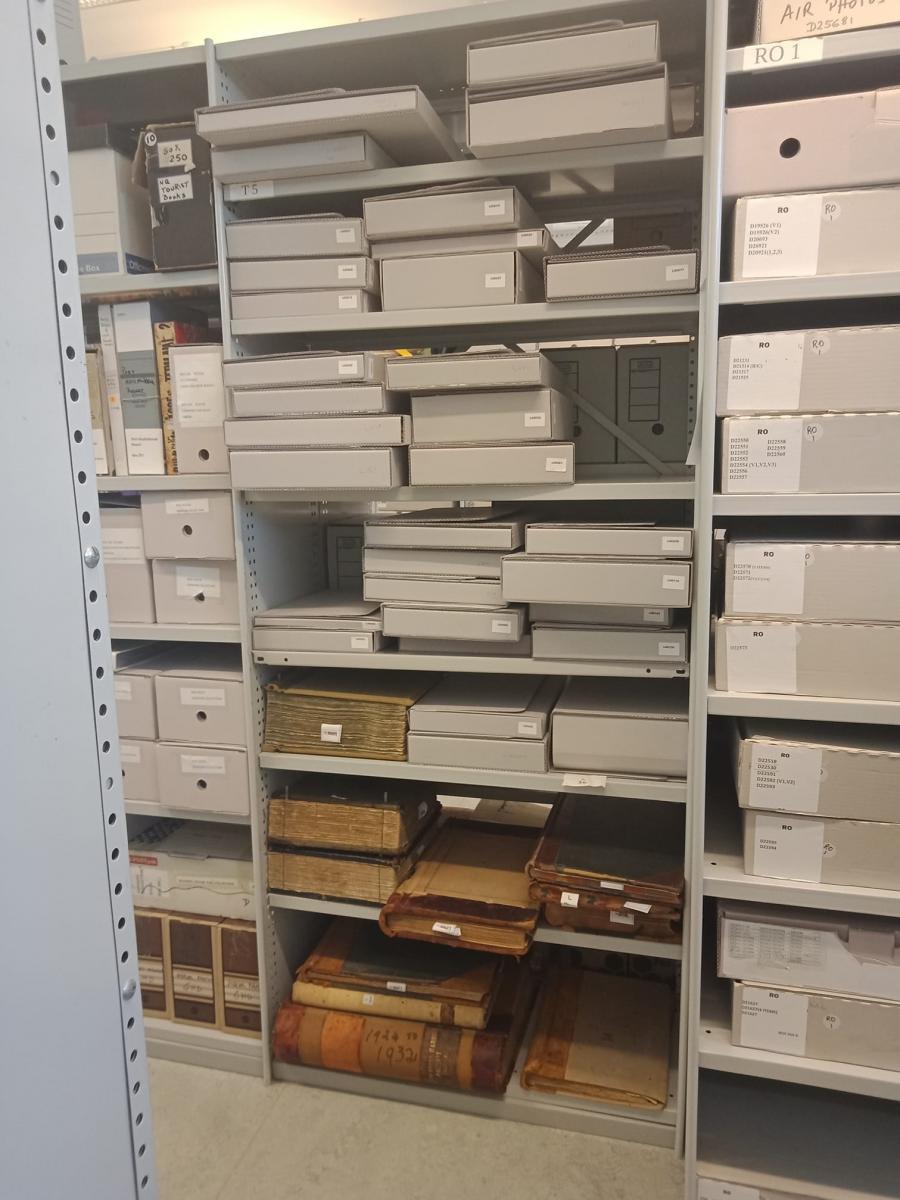
Melanie has also just welcomed a ductless fume hood cabinet to the mini-lab located on the 1st floor of the School of Arts building. With mould part and parcel of collection care in FNQ, the fume hood will be a huge asset for the collection. It and a Nilfisk vacuum cleaner were purchased with grant money awarded to the museum for their preservation efforts.
The Cairns Historical Society is a bustling organisation with a dedicated team of volunteers. We look forward to reporting on our activities and preservation work on this great collection in the Far North.
South Australia
Artlab Australia
Professional news
Treatment projects
Kristin Philips has just returned from Georgetown in Penang, Malaysia, after completing Capacity Training in Textile Conservation, working on the treatment of the Nine Emperors Banner at the Tow Boh Keong Temple. This was a joint project between Artlab Australia and Georgetown World Heritage Incorporated (GTWHI).
Kristin has visited Georgetown several times to train and work with local conservators and volunteers. The team, with her assistance, has undertaken the treatment of the fragile hand-embroidered Chinese banner, which has hung at the temple since in was made in 1900. It is 3.5 metres long and 75 cm wide.
Treatment commenced in January and the banner was disassembled and a new silk lining inserted. All of the fragile silk was then couched onto the new lining. The loose gold thread was realigned and stitched into position. Over the last seven months, led by local conservator Annie Lee, the team of volunteers tirelessly and meticulously carried out the stitching with approximately 1500 hours of work. In July, Kristin returned to assist with the reassembly and installation of the banner into the purpose-built display case. All work was undertaken in the temple and the banner will continue to be displayed and used in the temple into the future. (See below)
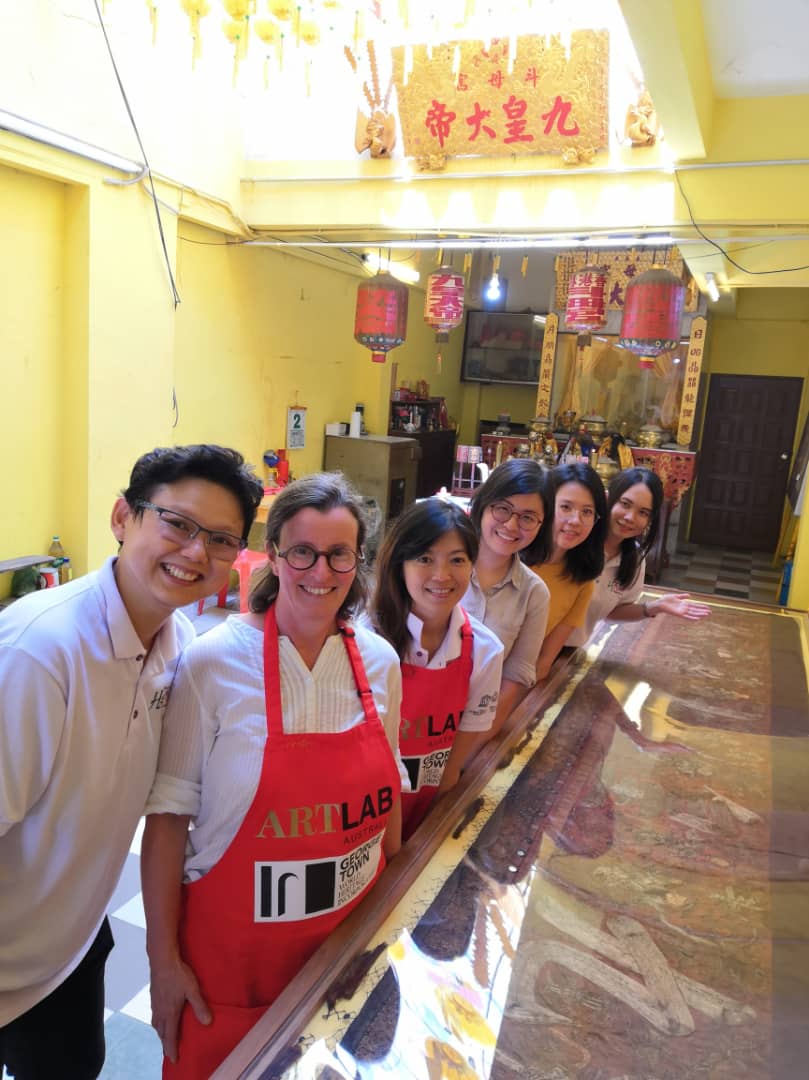
Megan Sypek has come to the end of a long treatment on a Chinese theatre cabinet. The spectacular wooden cabinet dates to circa 1900, and features 12 decorative doors, drawers and panels. Each of these elements frames an elaborate, three-dimensional carved ivory flower.
The treatment involved laser cleaning the ivory elements and replacing the many missing, broken, and misaligned pieces. Distracting historical repairs and excess adhesive were reversed and removed. Selecting a material to model the missing elements presented a serious ethical dilemma; to use ivory or replace with an alternative? After many experiments and discussions with the client, FIMO polymer clay was selected as an appropriate material. Thus ‘Fauxvory’ was born.



Once a technique was decided upon it was simply a case of getting through the large volume of work. The conclusion of the treatment saw the cabinet in sound, clean condition, with visually cohesive decoration. Both Megan and the client were happy with the outcome and satisfied by the journey to get there. See images below, which show the transformation that the panels and cabinet underwent.

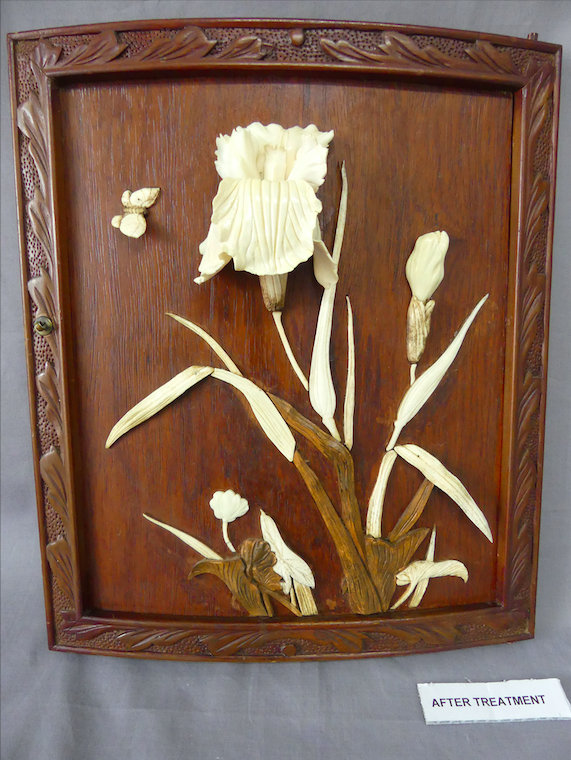

The Objects lab team welcomed student Margaret Barclay from the University of Melbourne, Masters of Cultural Materials Conservation programme. Margaret has an interest in objects and textiles and as such she was able to assist with many varied tasks and treatments during her three weeks with us. These included brush-vacuuming an early leatherwork frame (see Image 8, below), creating a covered shaped form—suitable for storage and display—for a cuirass chest piece from PNG, undertaking extensive fills and in-painting on a large Milton Moon ceramic bowl, and assisting with our vehicle maintenance program at the National Motor Museum in Birdwood in the Adelaide Hills. We thank Margaret for her time with us and wish her all the best with her remaining studies.
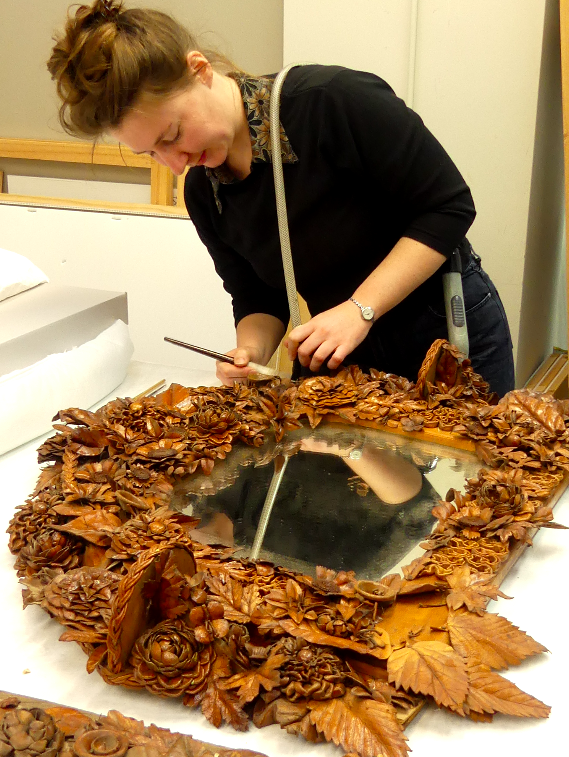
Tasmania
Libraries and Archives Tasmania
Staff changes
Jan Smith has been working in a relief capacity to identify, list and re-house a part of the massive photographic collection deposited with us from the Mercury newspaper. She has worked periodically over four years and now will be moving to a permanent job elsewhere. It is estimated that she has dealt with around 6,000 images. We will miss Jan and her knowledge of the collection and incredible work ethic.
Treatment projects
Stephanie McDonald treated an 1832 survey plan of Hobart and Glenorchy which had an old conservation tape in segments across a long central crack in the heavy paper. Fortunately the tape could be removed with water and the adhesive could be mechanically rolled off. The plan is to be digitised for a client. Stephanie has also been working with the access and digitisation team to prepare procedures and guidelines for handling and scanning large boxes of Tasmanian Railway records that were burnt in the 1970s.
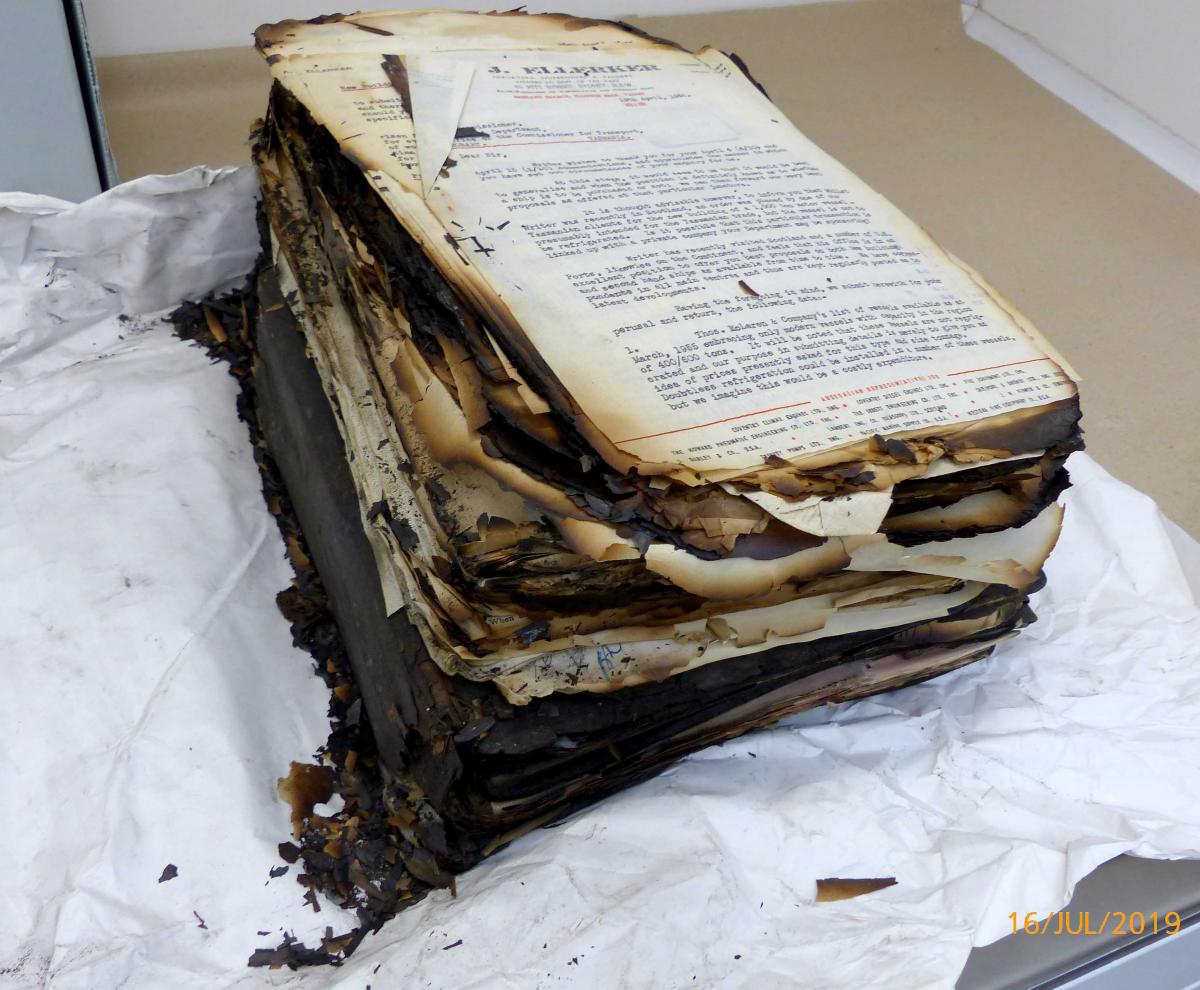
Conservation Officer Gaynor Tollard has been re-housing about 250 photographs from the Mt Lyell Mine, which were on large chunks of chipboard. The chipboard has been reduced to a thin layer and will have a buffer board placed in with each photograph. If a photograph is required for digitisation or exhibition, we will then consider removing the final layer, if possible.
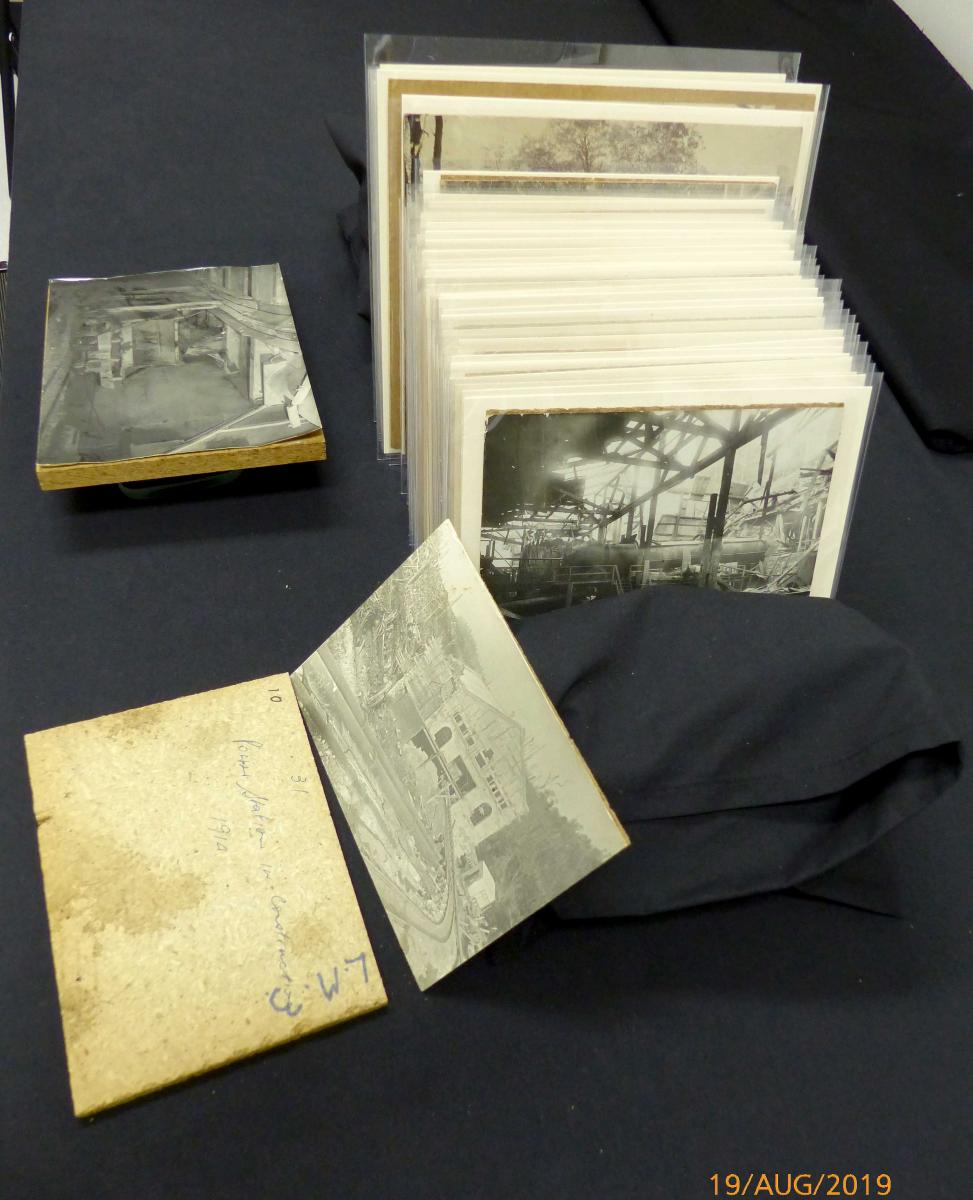
Gaynor has also been very busy boxing items ranging from volumes and sketchbooks to miniatures on ivory and small framed silhouettes from the WL Crowther Library.
Exhibitions
The exhibition in the Allport Gallery will change over at the end of the month with Feeling Blue coming down and an external artist, Caroline Amos, installing her exhibition about Jorgen Jorgensen. Conservation staff will be busy de-framing the Blue works and returning items to storage.

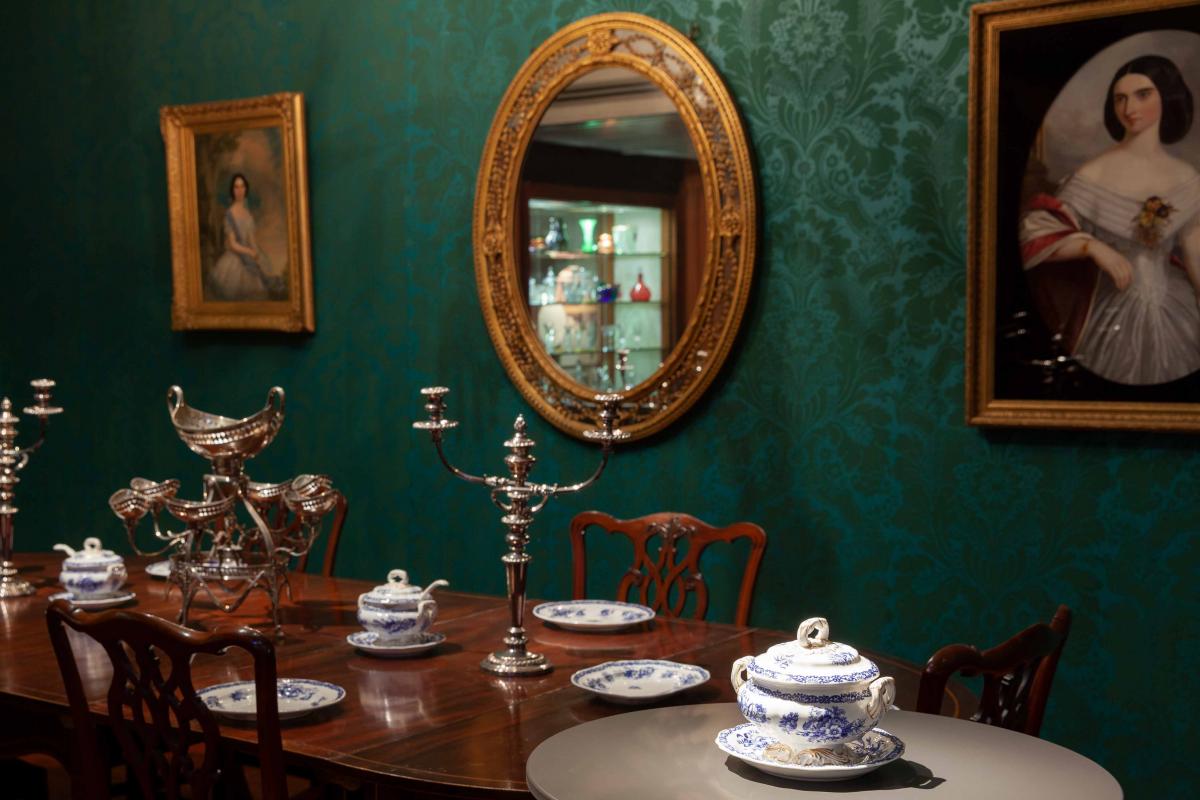
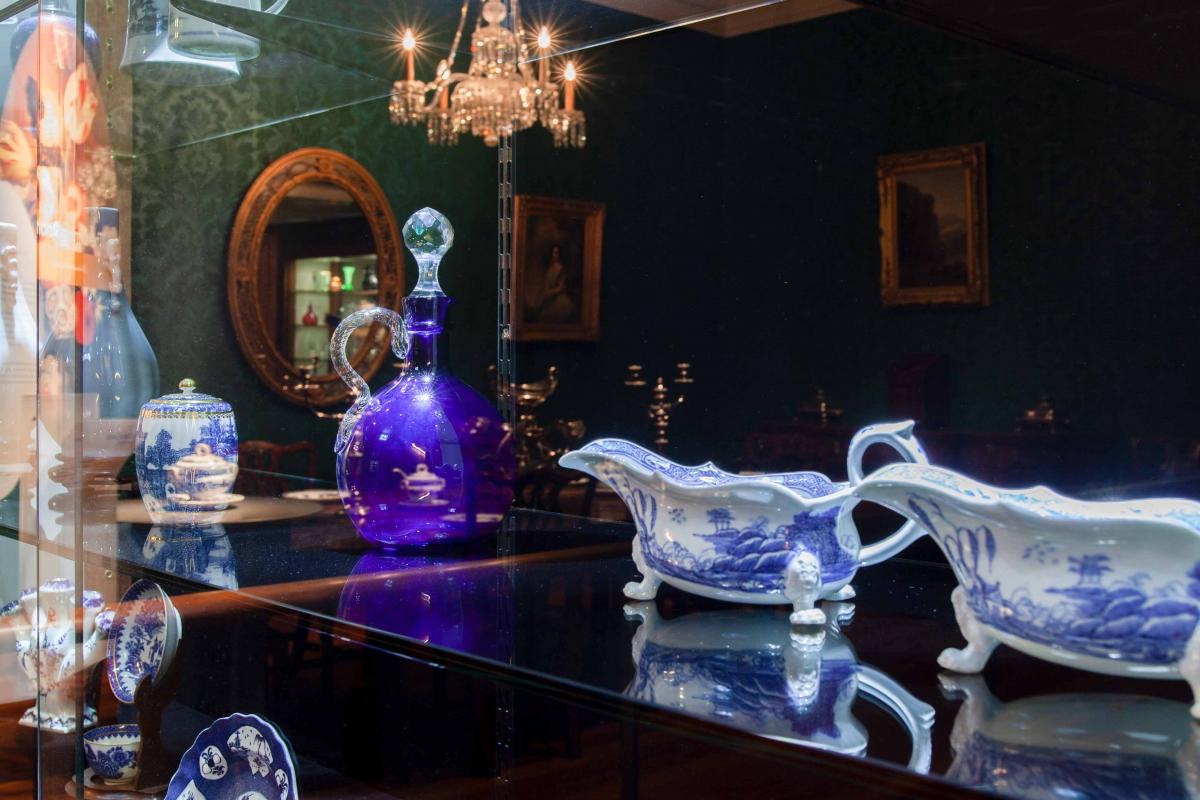
Victoria
Arts Centre Melbourne
Reimagining Project
As the Reimagining Project, a part of Melbourne’s Arts Precinct Transformation (MAPT), is gaining momentum at Arts Centre Melbourne (ACM), the Collections team is focusing on specific elements and projects within the Australian Performing Arts Collection (APAC) and Public Art Collection (PAC).
Conservator Carmela Lonetti and Registrar Jenna Blyth, along with wonderful conservation student volunteers Mar Cruz, Katrina Watson, Rachelle Bridges, Marie Claire Petrowski and Kate Ritchie, have completed a thorough conservation assessment of the Public Art Collection (PAC) on permanent display in the Theatres Building foyers, and are still working through the collection in the art store. This detailed work has contributed to the development of the ‘Art Collection Strategy’ and towards the future display, treatment and preservation of the PAC.
In addition, one of the first projects to be realised in the redevelopment of the Theatres Building is the upgrade of the theatre’s fly system. The State Theatre Curtain, which is a heritage-listed object, will need to be removed for the duration of building works scheduled for September 2020, affording the first opportunity since it was installed in 1984 for cleaning and conservation treatment to be undertaken. The size and scale of the curtain present many exciting challenges in the coming months.
The Reimagining Project has also included an application to amend the registration of the Arts Centre Melbourne in the Victorian Heritage Register (VHR). Samantha Hamilton, Head of Collections, Preservation and Access, has been working on this amendment with the curatorial team and Reimagining Project team. The amendment now includes additional land and objects integral to ACM, as previously only the ACM buildings were listed. Objects integral to ACM include significant items from the Public Art Collection including paintings and outdoor sculptures, original furniture, architectural drawings and models by Roy Grounds and John Truscott. The amendment of the registration has also provided an opportunity to update the statement of significance to reflect the amendments and update the permit policy and permit exemptions.
Opera Australia Documentation Project
Conservator Karen Fisher’s secondment from Museum Victoria to work on the Opera Australia Documentation Project has seen the successful completion of over 550 conservation assessments of objects ranging from costumes, accessories, designs, toiles, and archival material relating to the history of opera in Australia and the career of Dame Joan Sutherland. Karen has also been intimately involved in the comprehensive image capture of the items including trialling 3D scanning for two costumes, and the development of innovative and bespoke rehousing and long-term storage strategies.
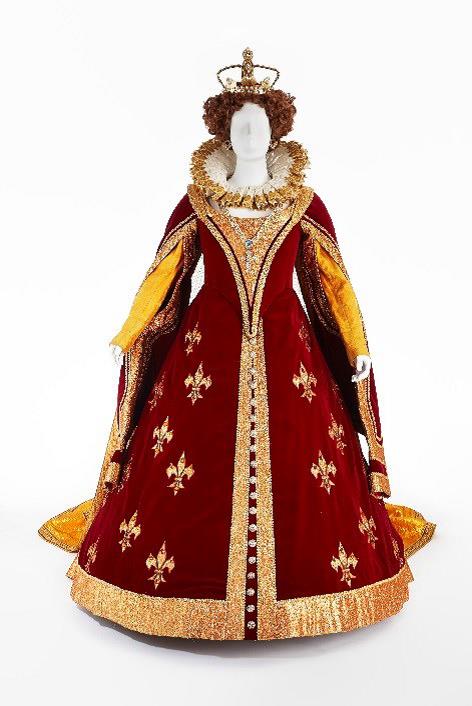
Working closely with Fiona Wilson, Assistant Registrar and Erina McCann, Tiaki Objects Conservation, Karen is continuing with the second stage of the project. With customised storage solutions fabricated, the satisfying task of rehousing 550 complex items is being realised.
Professional development training for Collections team
Karen Fisher, Carmela Lonetti and Kate Hodgetts (trained paper conservator currently working as an Assistant Registrar on the Legacy Data Project at ACM) delivered an Object Handling workshop to consolidate the Collection team’s existing skills.
Musical Curiosities display
Carmela Lonetti and Karen Fisher also recently visited musical instrument maker and conservator Ian Watchorn. Ian very generously shared his knowledge and demonstrated the nuances of replacing and tensioning strings on two viola da gambas from the Australian Performing Arts Collection. These instruments were made by renowned Australian instrument maker John D Johnstone and will be on display in Hamer Hall, along with imaginative original instruments made by Australian leather sculptor Garry Greenwood.
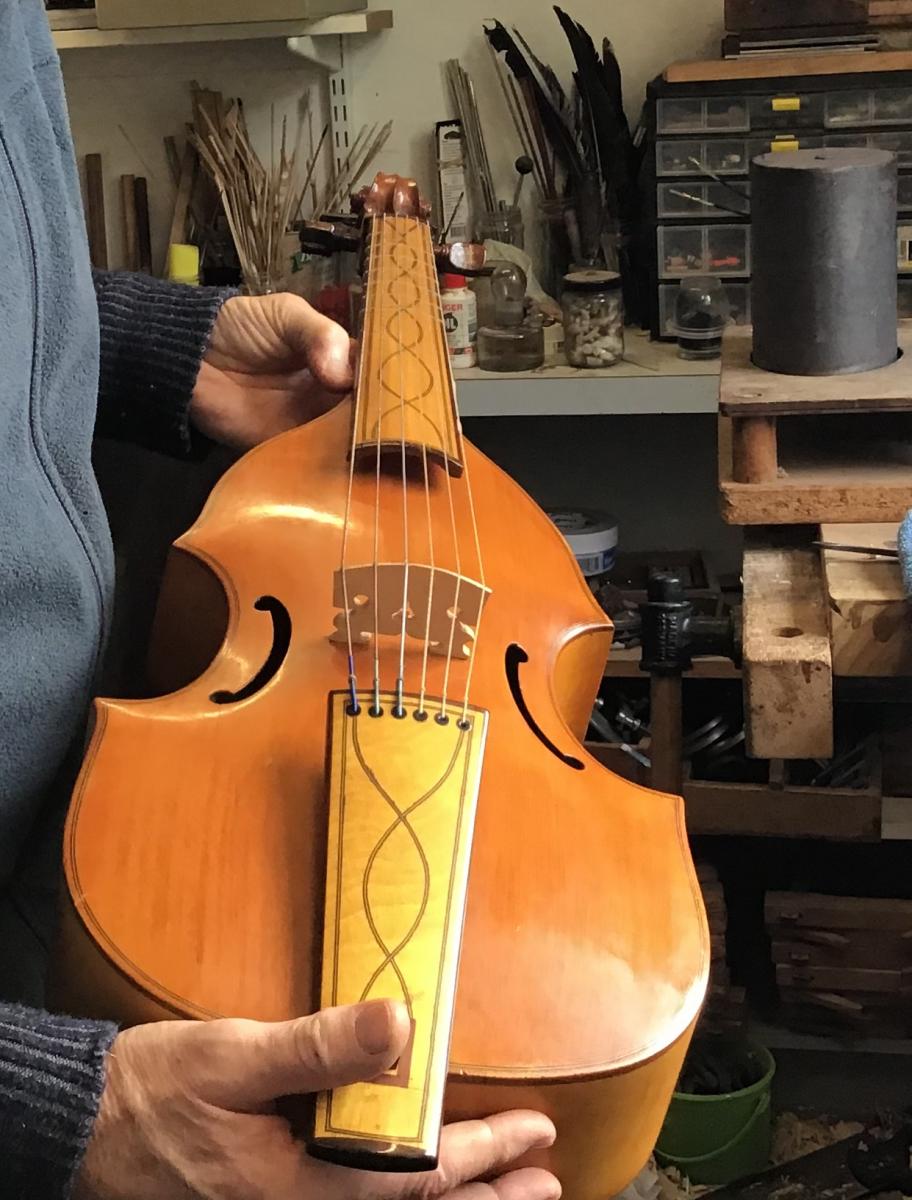
National Gallery of Victoria
General news
The Conservation department has hosted a number of interns: Murphy Bouma as a painting intern, Bella Lipson in the Frames and Furniture department and Annabel Livingstone in the Textiles department, all of whom are students from Melbourne University Master of Cultural Materials Conservation.
MaryJo Lelyveld attended the AGNSW ‘Towards a Flexible Future’ time-based media art preservation workshop with the NGV Senior Curator of Contemporary Art, and they are now currently working with colleagues from across the multimedia, IT, registration, curatorial and conservation departments to develop a strategy for managing its legacy TBA collection and incoming acquisitions. Michael Varcoe-Cocks has commenced the on-line phase of the ten-month Getty Conservation Institute ‘Preserving Collections in the Age of Sustainability’ course. Michael and MaryJo, along with colleagues at QAGOMA and AGNSW and other galleries represented as part of the Council of Australasian Art Museum Directors (CAAMD), are working on applying the Bizot Green Protocol to loan galleries’ environments. A day-long roundtable was hosted by the NGV to discuss pathways to implementation.
All departments have been utilising the FTIR to collate a broad range of spectra and in particular the Frames and Furniture team has found it very useful in analysing the variety of spectra contained within the gilding of collection items’ frames.
In August, Senior Textiles Conservator Skye Firth held a lecture in conjunction with AMaGA Victoria, ‘Caring for and displaying costume collections’, at Coal Creek Community Park and Museum, covering advice on how to ensure costumes and textiles are preserved as well as best practice storage methods.
In July the painting department delivered a lecture for the ADFAS group in conjunction with AICCM entitled ‘Behind the Scenes at the NGV’, which covered each painting conservator’s specific areas of interest and research, interestingly with the common theme of varnishes coming through. The lecture to ADFAS members was an opportunity to thank ADFAS for its on-going support of the AICCM through the Patricia Robertson Fund.
Textiles
Kate Douglas, Ellen Doyle, Skye and Di Knight have been focused on the upcoming Collecting Comme show with the preparation of around 70 items for display. Also, the closing of the amazing Krystna Campbell Pretty fashion gift exhibition has meant the team assisted with the de-install of the items and undressing the mannequins as well.
The continual acquisition of fashion items has also kept the department busy, as have permanent collection changeovers, which included the display of a rare, complete, 18th-century man’s outfit replete with pink satin and embroidery.
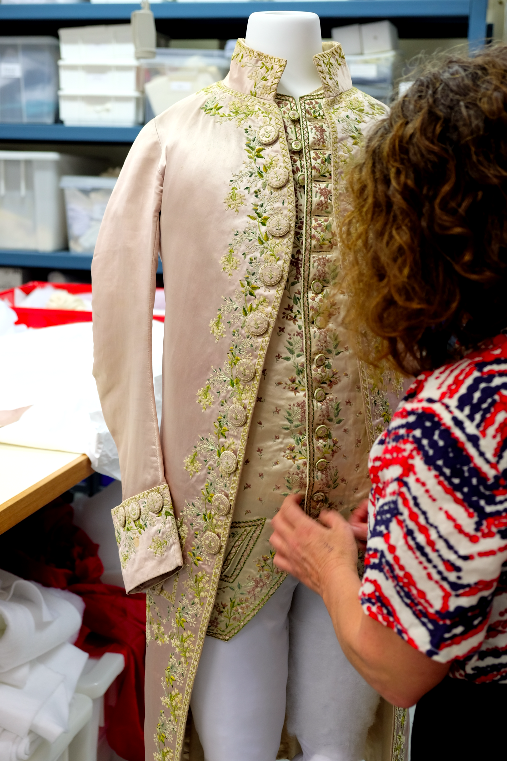
Painting
In August the NGV paintings conservation studio welcomed University of Melbourne student Murphy Bouma for a three-week internship. Murphy has participated in a series of studio projects including the examination and treatment of a 1986 Warlpiri painting on hardboard by Billy Japaljarri Hogan, technical examination of two British paintings in the NGV collection, and X-radiography of four paintings.
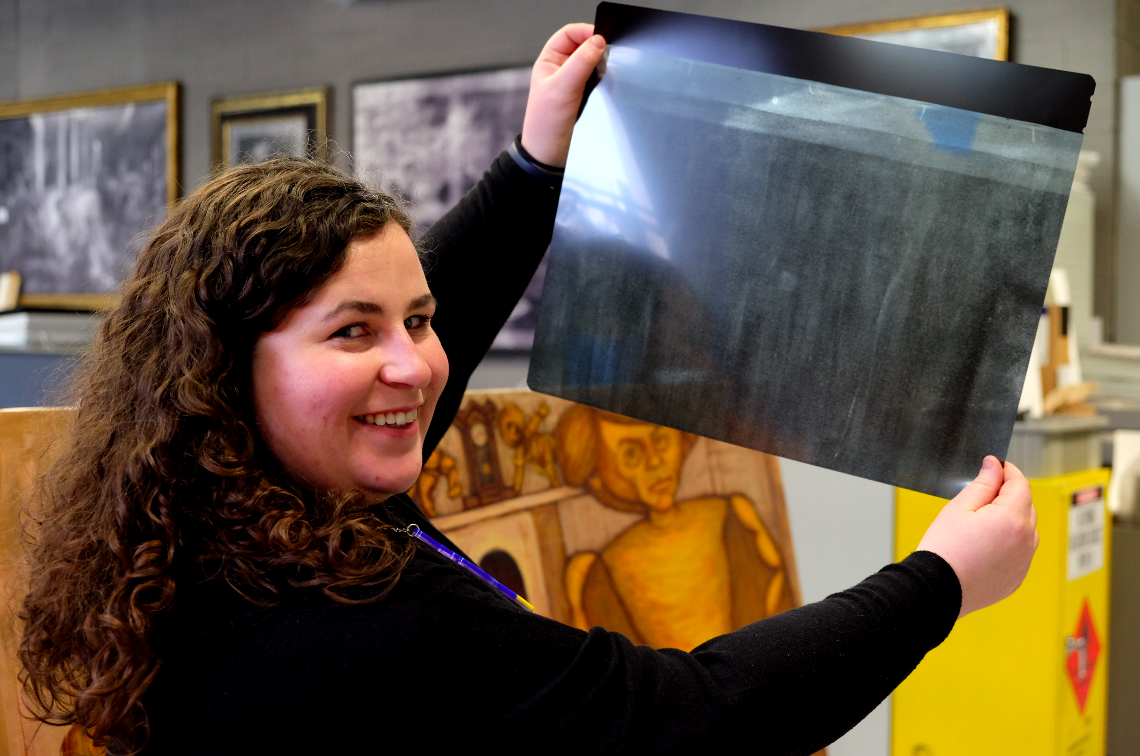
Raymonda Rajkowski has commenced a collection-wide survey of bark paintings in the NGV, including materials analysis utilising a handheld FTIR spectrometer. She has treated a series of paintings by Roger Kemp in preparation for the major exhibition on the artist, which opened to the public on 22 August 22. Raye Collins, who also contributed to the Roger Kemp exhibition, has continued her major treatment of Hugh Ramsay’s A student of the Latin Quarter (1901).

Michael Varcoe-Cocks is in the final stages of his treatment on Hugh Ramsay’s Consolation (1889–1901). Caitlin Breare has carried out the removal of old varnish and layers of overpaint from Thomas Clark’s The Upper Falls on the Wannon (1867) and has begun technical examination of a group of paintings by John Constable in the NGV collection.
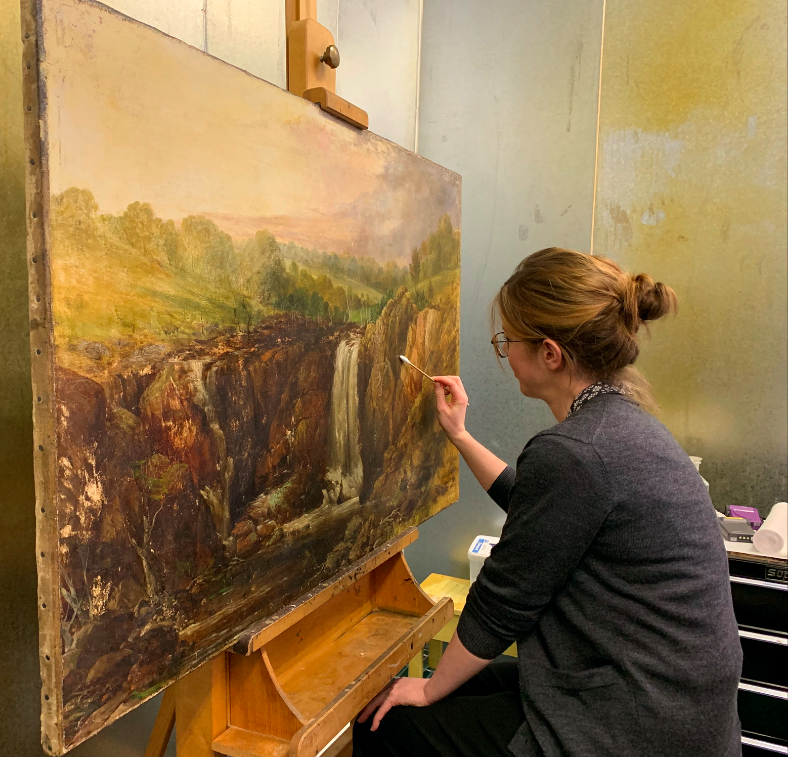
Carl Villis has cleaned two new acquisitions by British artists, a portrait of Lady Elizabeth Hamilton (1771) by Anne Forbes, and a large full-length portrait by Annie Swynnerton, painted in 1878.
Frames and Furniture
The Frames and Furniture section has seen Suzi Shaw busy with new acquisitions including a Danish chair, as well as writing a major piece for the NGV magazine, and working on Japanese lacquer pieces in preparation for their future display.
Holly McGowan-Jackson and Jason King have completed reproduction frames for Buvelot Mt Martha from Dromana’s Hill (1877) and McCubbin Portrait, (1893). They are also researching and beginning reframing projects as part of the Centre for Frames Research, including a Cumbrae-Stewart and Fred Williams.

Holly, MaryJo and Jessica Lehmann have been undertaking extensive research and writing up various pieces for the soon-to-be-launched Centre for Frames Research website, which will be a repository of frame information.
Exhibitions
The past few months have seen Exhibitions and Loans conservators Catherine Earley and Janelle Borig busy with the recent exhibition changeovers across both sites, and hard at work preparing for large scale exhibitions including KAWS and Haring/Basquiet with a variety of lenders to liaise with.
Paper and Photography
In the Paper and Photography studio, Ruth Shervington has undertaken technical examination of two 19th-century, ten-panel, Korean folding screens, focusing particularly on the identification of media. These are new acquisitions and are important additions to the NGV collection. Louise Wilson also spent time overseas as part of a generous Clemenger travel grant researching William Blake works on paper.
Ruth and Louise have prepared a large group of Lajamanu paintings for display at NGVA in August. The works are extremely fragile due to the materials used to create them and a system has been devised to display them unframed. Whilst preparing this discrete group for display, the packaging and storage of all Lajamanu works in the NGV collection was reassessed and improved.
Pip Morrison and Ruth have been focused on exhibition preparation for Olympia: Polixeni Papapetrou, Civilization: The way we live now and Petrina Hicks: Bleached Gothic. She has also prepared a number of photographs for loan to exhibitions commemorating the anniversary of the moon landing and condition reported 130 Robert Rooney works for acquisition.
Objects
The NGV objects team of Marika Strohschnieder, Trude Ellingsen and Dianne Whittle continue to be involved in several collection changeovers at both NGV sites including the recent reinstallation of the Ancient Worlds galleries. They each also have more comprehensive treatments on the go and are currently working on Jacob Epstein’s Male Figure, David Wire’s Abstract construction (1969) and a German Pietà from the 17th century. The displays of Painting change: Indigenous art from the collection and KAWS not only require assistance in matters relating to installation, collection care, documentation, and Eamon O’Toole and Ben Raynor with display mount making, but also provide interesting opportunities for collaboration with external parties.
Western Australia
State Library of Western Australia
At the State Library of Western Australia, the conservation area has been busy working on various tasks, most recently including detecting and measuring the severity of acetate film deterioration within the State Heritage film collection, preparing films for digitisation, treating mouldy items that have been identified to be brought into the collection and the conservation treatment of paper items.
In September, we will be involved in the de-installation of Stranded, an exhibition based on the illustrated picture book by Jan Ramage and featuring original artwork from the book, brought together with draft sketches, photographs, newspaper articles and more. Concurrently we will be preparing for the next exhibition, Violet & Nothing, which is part of the AWESOME Festival. This will include matting, hinging and framing six original illustrations.
The conservation area has also welcomed a new volunteer, Erin Vlajsavljevich, who previously completed an internship at SLWA. Erin has been undertaking a systematic examination of the physical and digital condition of compact discs form the SLWA Heritage Sound Recording collection, which so far has been found to contain CD-R and CD-ROM format discs. As these discs have often had a life before being donated to the library the condition can widely vary, and this project was instigated to get a baseline at this point in time. The preliminary results of the examination appear to show that discs manufactured in the CD-R format have higher levels of deterioration, whilst CD-ROM format discs, regardless of age, are in relatively good condition. Obsolescence was out of scope for this project. These results will inform future actions towards this collection.